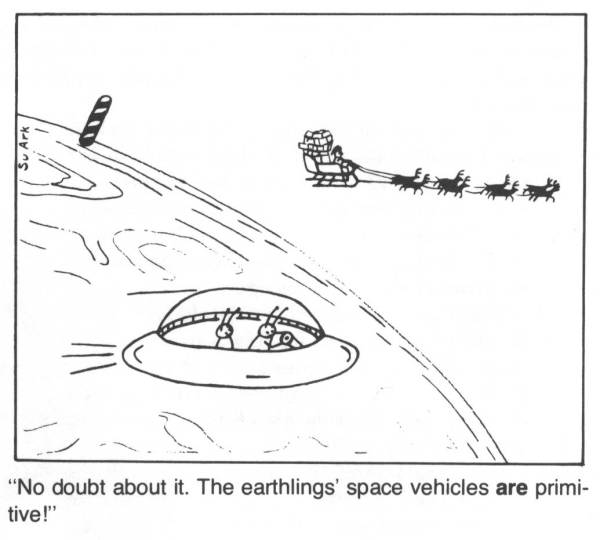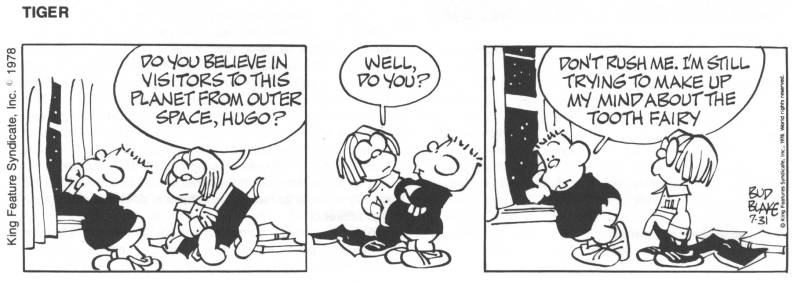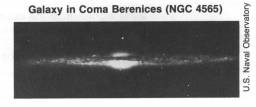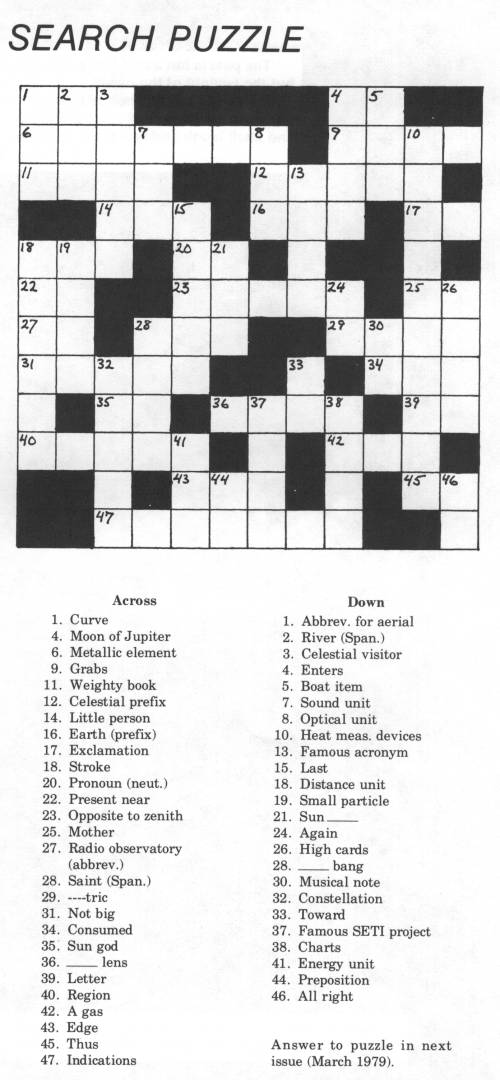![[NAAPO Logo]](../../Images/NAAPOsm.jpg)
North American AstroPhysical Observatory (NAAPO)
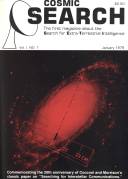
Cosmic Search: Issue 1
(Volume 1 Number 1; January 1979)
[All Articles & Miscellaneous Items]
|
Webpage Table of Contents (Bookmarks)
(Internal links to items in this webpage)
[Note. Use Back button (or <Alt>+<Left Arrow>) to get back to this Table of Contents after you have clicked on a link and viewed the article.]
Codes Used Below:
P: Starting page of article in magazine; A: Author(s); T: Title of article
|
Editorial: About COSMIC SEARCH and SETI
By: Robert S. Dixon and John Kraus, Editors
[Article in magazine started on page 2]
The Search for Extra-Terrestrial Intelligence (SETI) is an idea whose time has come. A decade or so ago only a handful of scientists were active in this area; actual searches were almost non-existent and few people had heard of SETI. But today hundreds of scientists are actively involved, a dozen radio observatories around the world are carrying out actual searches, and much serious thinking is being devoted to SETI.
This change in attitude and interest is highlighted in this premier issue of COSMIC SEARCH by commemorating the 20th anniversary of the trail-blazing paper on "Searching for Interstellar Communications" by Giuseppe Cocconi and Philip Morrison and the 19th anniversary of Frank Drake's pioneering project OZMA. Jocelyn Burnell's article on the discovery of pulsars adds a further historical note.
This and subsequent issues of COSMIC SEARCH will present articles about all aspects of SETI in a manner that the general reader will easily understand. COSMIC SEARCH will help a reader learn the real story of SETI as distinguished from the fantasy and pseudo-science which abound in the mass media and to find out that the facts can be more fascinating and amazing than any fiction.
We plan to publish articles involving the biology, sociology, philosophy, technology, theology and many other facets of SETI. We intend to make the articles enlightening, exciting and entertaining.
It has been aptly said that SETI is also a search for ourselves and that one of its most important immediate benefits will be to provide us a better insight into the solution of our own present problems here on earth.
When people first hear about SETI, they ask all the normal questions, like: How do we know there is anyone out there? Why should we try to find them? How could it benefit us? Even if we found them, how could we ever hope to understand their language? What good is it to talk to someone if it takes 1000 years for each exchange? There are good answers to all these questions, but there are no simple ones. These questions and many others will be dealt with at length by COSMIC SEARCH authors.
Our distinguished Editorial Board members are not only currently active in SETI, but most have been for many years. We and our observatory staff are directly involved in one of the largest actual searches to date. This collective first-hand experience insures that COSMIC SEARCH will be both responsible and authoritative.
Mankind's most important question may well be whether, in all the vastness of the universe, we are alone. Paraphrasing Lee DuBridge, Science Advisor to President Eisenhower, "Either we are alone or we are not; either way is mind boggling."
The earth is mankind's cradle and although we are a very young, emerging civilization and still in our cradle, we are now adolescent enough to look beyond that cradle and acquire a cosmic perspective. Only by achieving a true view of ourselves as we relate to the planets and stars of our galaxy and the universe beyond can we attain maturity. SETI is a first step toward the growing up of mankind; COSMIC SEARCH is a step toward the growing up of SETI.
Robert S. Dixon and John Kraus, Editors
"Either we are alone or we are not; either way is mind boggling."
|
|
Editorial: Science and The Multitudes
By: Richard Berendzen
[Article in magazine started on page 3]
Decades ago, C. P. Snow said that the multitudes had about as much communication with M.I.T. as though the scientists spoke nothing but Tibetan." Despite the vast funding spent on innovative educational projects during the past twenty years, the situation probably has only worsened since Snow. Scientific knowledge has increased exponentially while public understanding of science has grown linearly at best. While new scientific discoveries flooded in, universities reduced broadening requirements, schools at all levels lessened standards, and the public bewildered by a complex world, lost faith in technology and blamed science. How lamentable in the short span of life to know only about man and virtually nothing about the world. How preposterously arrogant. How chauvinistically egocentric.
Tragically, one of the most important contributors to the sad state of society's scientific intellect has been higher education itself. In our recent genuine zeal for educational reform, grieviously overdue, we often have failed shamefully to maintain, much less enhance, the academic standards that produced our modern world. Like a thunderous juggernaut, whose inertia resists motion but whose momentum becomes colossal, higher education in the 1960's began to swing, crushing much before it, both good and ill. Out went universities' insensitivity to teaching effectiveness, but also out went many professors' rigor. Out went truly irrelevant curricula, but also out went parts of the core of civilized thought. Out went oppressive general education requirements, but also out went the unparalleled richness of a liberal and liberating education.
While our nation lands on Mars, delves into the gene, sweeps Nobel prizes for 1976 (all accomplishments made by graduates of another era), our recent educational system has produced a generation bordering on functional illiteracy. In no area has this been more the case than in scientific understanding by non-science students.
And earlier generations of non-scientists often seem scarcely better informed. Receptions, even those frequented by academic literati and industrial tycoons, give the astronomer pause, for inevitably he will be asked, "Can you guess people's astrological signs?" (Probably, about one time in twelve.) "Don't you think Velikovsky is brilliant?" (Yes, he sold many books.) "Why did They place the Bermuda Triangle in the ocean?" (So that ships and planes would disappear, not cars and trains.) "Why do the Air Force and NASA conspire to hide the awful truth about UFO's?" (To keep their budgets modest.) "What did ancient astronauts teach Peruvian Indians?" (Not law or medicine, but how to draw giant beetles.)
Why this public fascination with the exotic and the pseudo-scientific, especially when the world of circumstance is infinitely more subtle and surprising? The popular, mystical theories are necessarily limited by human imagination, whereas the Universe itself, as J.B.S. Haldane put it, is not queerer than we suppose but queerer than we can suppose.
Our current students need to experience Close Encounters of at least three kinds — with logic, with math, and with science. If presented well, science fact can be far more engaging than science fiction; moreover, as Carl Sagan has noted, it has the additional value of being true.
Or at least it constitutes our current understanding of truth. Actually, scientific "facts" themselves evolve, changing as our information and insights improve. Contrary to frequent popular opinion, science is not merely a body of codified absolutes, immutably fixed; rather, it is a dynamic venture, possessing all the strengths and weaknesses, logical or illogical, that typify any human enterprise.
"Students need to experience Close Encounters of at least three kinds — with logic, with math and with science."
But, in truth, it must be conceded that science and scientists themselves deserve much of the blame for the current public level of scientific understanding. Ironically, as modern astronomy has brought forth some of the most mind-boggling concepts ever encountered (e.g., pulsars, starquakes, black holes, worm holes, quasars, primordial collapsars), the esoteric yet plausible has sounded increasingly like the bizarre and pseudo-scientific, particularly to non-specialists. And surely no topic possesses that duality — of solid, cutting edge science vs. tawdry mysticism and charlatanry — more than does the search for extraterrestrial life.
Should scientists be surprised or offended when the public confuses respectable 21 centimeter searches with disreputable UFO accounts, particularly when the media widely and uncritically advertise the latter? Surely scientists, perhaps especially astronomers with their unusually high level of per capita Federal funding, owe a debt to the public that supports them, to explain the differences between findings and fads and to share with the widest possible audience what we know of nature's beauty.
And given the lamentable current state of public scientific literacy, this responsibility has never been greater.
Richard Berendzen
Member, Editorial Board of COSMIC SEARCH
|
|
Searching for Interstellar Communications
By: Giuseppe Cocconi* and Philip Morrison†
Cornell University, Ithaca, New York
* Now on leave at CERN, Geneva.
† Now on leave at the Imperial College of Science and Technology, London, S.W.7.
[Article in magazine started on page 4]
|
The year 1979 marks the 20th anniversary of the first publication in a scientific journal of a realistic strategy of a search for extra-terrestrial intelligence. The article, entitled "Searching for Interstellar Communications", was written by Giuseppe Cocconi and Philip Morrison, both then of Cornell University and appeared in NATURE.* By perceptive, incisive reasoning the authors develop the proposal that a search be made of some of the nearest sun-like stars for signals at or near the 21-centimeter wavelength of neutral hydrogen.
It is most appropriate that in this, the first issue of COSMIC SEARCH, this article by Cocconi and Morrison, now a classic of classics, is reproduced (with mathematics omitted). For historical interest, the first page of the article is reproduced just as it appeared. Following this article, Morrison reflects on the search from the perspective of two decades.—Eds.
* NATURE, vol. 184, no. 4690, pages 844- 846, Sept. 19, 1959. Reproduced by permission. Cocconi and Morrison's article in NATURE was sandwiched between an article on the electronic prediction of swarming in bees and one on metabolic changes induced in erythrocytes by x-rays.
|
No theories yet exist which enable a reliable, estimate of the probabilities of (1) planet formation; (2) origin of life; (3) evolution of societies possessing advanced scientific capabilities. In the absence of such theories, our environment suggests that stars of the main sequence with a lifetime of many billions of years can possess planets, that of a small set of such planets two (Earth and very probably Mars) support life, that life on one such planet includes a society recently capable of considerable scientific investigation. The lifetime of such societies is not known; but it seems unwarranted to deny that among such societies some might maintain themselves for times very long compared to the time of human history, perhaps for times comparable with geological time. It follows, then, that near some star rather like the Sun there are civilizations with scientific interests and with technical possibilities much greater than those now available to us.
To the beings of such a society, our Sun must appear as a likely site for the evolution of a new society. It is highly probable that for a long time they will have been expecting the development of science near the Sun. We shall assume that long ago they established a channel of communication that would one day become known to us, and that they look forward patiently to the answering signals from the Sun which would make known to them that a now society bas entered the community of intelligence. What sort of a channel would it be?
The Optimum Channel
Interstellar communication across the galactic plasma without dispersion in direction and flight-time is practical, so far as we know, only with electromagnetic waves.
Since the object of those who operate the source is to find a newly evolved society, we may presume that the channel used will be one that places a minimum burden of frequency and angular discrimination on the detector. Moreover, the channel must not be highly attenuated in space or in the Earth's atmosphere. Radio frequencies below about 1 Mc./s. (1 Mc./s. = 1 megacycle per second = 1 million cycles per second), and all frequencies higher than molecular absorption lines near 30,000 Mc./s., up to cosmic-ray gamma energies, are suspect of absorption in planetary atmospheres. The bandwidths which seem physically possible in the near-visible or gamma-ray domains demand either very great power at the source or very complicated techniques. The wide radio band from, say, 1 Mc. to 10 Mc./s., remains as the rational choice.
"No guesswork here is as good as finding the signal."
In the radio region, the source must compete with two backgrounds: (1) the emission of its own local star (we assume that the detector's angular resolution is unable to separate source from star since the source is likely to lie within a second of arc of its nearby star); (2) the galactic emission along the line of sight.
At what frequency shall we look? A long spectrum search for a weak signal of unknown frequency is difficult. But, just in the most favoured radio region there lies a unique, objective standard of frequency, which must be known to every observer in the universe: the outstanding radio emission line at 1,420 Me./s. (21 centimeter wavelength) of neutral hydrogen. It is reasonable to expect that sensitive receivers for this frequency will be made at an early stage of the development of radio-astronomy. That would be the expectation of the operators of the assumed source, and the present state of terrestrial instruments indeed justifies the expectation. Therefore we think it most promising to search in the neighborhood of 1,420 Mc./s.
In all directions outside the plane of the galaxy the 21-cm. emission line does not emerge from the general background. For stars in directions far from the galactic plane search should then be made around that wavelength. However, the unknown Doppler shifts which arise from the motion of unseen planets suggest that the observed emission might be shifted up or down from the natural co-moving atomic frequency by plus or minus approximately 300 kilocycles per second (corresponding to velocities of plus or minus 100 kilometers per second). Closer to the galactic plane, where the 21-cm. line is strong, the source frequency would presumably move off to the wing of the natural line background as observed from the direction of the Sun.
Nature of the Signal and Possible Sources
No guesswork here is as good as finding the signal. We expect that the signal will be pulse-modulated with a speed not very fast or very slow compared to a second, on grounds of band-width and of rotations. A message is likely to continue for a time measured in years, since no answer can return in any event for some ten years. It will then repeat, from the beginning. Possibly it will contain different types of signals alternating throughout the years. For indisputable identification as an artificial signal, one signal might contain, for example, a sequence of small prime numbers of pulses, or simple arithmetical sums.
The first effort should be devoted to examining the closest likely stars. Among the stars within 15 light years, seven have luminosity and lifetime similar to those of our Sun. Four of these lie in the directions of low background. They are Tau (τ) Ceti, Omicron 2 (ο2) Eridani, Epsilon (ε) Eridani, and Epsilon (ε) Indi. All these happen to have southern declinations. Three others, Alpha (α) Centauri, 70 Ophiucus and 61 Cygni, lie near the galactic plane and therefore stand against higher backgrounds. There are about a hundred stars of the appropriate luminosity among the stars of known spectral type within some fifty light years. All main-sequence dwarfs between perhaps GO and K2 with visual magnitudes less than about +6 are candidates.
"The probability of success is difficult to estimate, but if we never search the chance of success is zero."
The reader may seek to consign these speculations wholly to the domain of science-fiction. We submit, rather, that the foregoing line of argument demonstrates that the presence of interstellar signals is entirely consistent with all we now know, and that if signals are present the means of detecting them is now at hand. Few will deny the profound importance, practical and philosophical, which the detection of interstellar communications would have. We therefore feel that a discriminating search for signals deserves a considerable effort. The probability of success is difficult to estimate; but if we never search the chance of success is zero.

 Giuseppe Cocconi is research physicist at the Centré Européen Recherche Nucléaire (CERN) in Geneva, Switzerland where he has been for the past 16 years. Born in Como, Italy, in 1914, receiving his doctor's degree from the University of Milan in 1937, teaching physics there and at the University of Catania (Italy), he became professor of physics at Cornell University in 1947 where he stayed until going with CERN in 1963. His interests include atomic particle interactions, cosmic rays and radio astronomy.
Giuseppe Cocconi is research physicist at the Centré Européen Recherche Nucléaire (CERN) in Geneva, Switzerland where he has been for the past 16 years. Born in Como, Italy, in 1914, receiving his doctor's degree from the University of Milan in 1937, teaching physics there and at the University of Catania (Italy), he became professor of physics at Cornell University in 1947 where he stayed until going with CERN in 1963. His interests include atomic particle interactions, cosmic rays and radio astronomy.
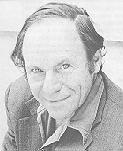 Philip Morrison has been professor of
physics at the Massachusetts Institute of Technology since 1965. Born in
Somerville, New Jersey, in 1915 he earned his Ph.D. degree at the University
of California in 1940 and then taught physics at San Francisco State College
and the University of Illinois. Following two years as group leader at the
Los Alamos Scientific Laboratory he was on the physics faculty of Cornell
University from 1946 to 1965. Dr. Morrison has won a number of prizes for
his work including the Pregel prize (1955), Babson prize (1957), and the
Oersted Medal (1965). His interests are in the application of physics to
astronomy. Author of numerous articles, many on SETI, participator in many
SETI conferences and workshops, he recently was chairman of a NASA SETI
advisory committee. He is a member of the Editorial Board of COSMIC SEARCH
and for many years he has been book editor of "Scientific American". Philip Morrison has been professor of
physics at the Massachusetts Institute of Technology since 1965. Born in
Somerville, New Jersey, in 1915 he earned his Ph.D. degree at the University
of California in 1940 and then taught physics at San Francisco State College
and the University of Illinois. Following two years as group leader at the
Los Alamos Scientific Laboratory he was on the physics faculty of Cornell
University from 1946 to 1965. Dr. Morrison has won a number of prizes for
his work including the Pregel prize (1955), Babson prize (1957), and the
Oersted Medal (1965). His interests are in the application of physics to
astronomy. Author of numerous articles, many on SETI, participator in many
SETI conferences and workshops, he recently was chairman of a NASA SETI
advisory committee. He is a member of the Editorial Board of COSMIC SEARCH
and for many years he has been book editor of "Scientific American".
|
|
Twenty Years After . . . .
By: Philip Morrison
[Article in magazine started on page 7]
A magnificent piece that links the past to the future with some very sage advice.—Eds.
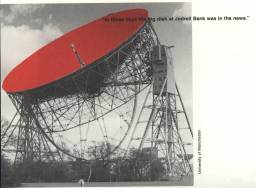
"In those days the big dish at Jodrell Bank was in the news."
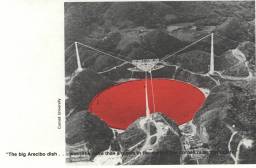
"The big Arecibo dish . . . was little more than a gleam in the eyes of the Cornell radio physicists."
Twenty years may be long enough to justify a few personal reminiscences. They begin during a chamber music performance in the Cornell Student Center when I first came to think about the promise of gamma-ray astronomy. The idea seemed good, and I am afraid I paid less than due attention to the quartet. By the end of 1958, I had published the first summary of what one might learn from gamma ray astronomy. Like most theorists, I badly underestimated the experimental difficulties and it was to take almost fifteen years before innovative experiments produced results. But the paper was interesting and made the challenge an inviting one.
One spring day, a few months after its publication in 1959, my ingenious friend Giuseppe Cocconi came into my office, which looked northward out over a small lake to the green hills of Ithaca. Giuseppe posed an unlikely question. Would not gamma rays, he asked, be the very medium of choice for communication between the stars? They would work, that was plain, and my answer was enthusiastic yet cautious. Shouldn't we look at all of the electromagnetic spectrum for its possibilities, and genuinely seek out the best means for such a link?
"We have passed through what I would call the pioneer stage."
In those days the big dish at Jodrell Bank was in the news, and the fiasco of Sugar Grove was in the planning stage. I do not recall whether we knew even the mere rumor of the big Arecibo dish, then perhaps little more than a gleam in the eyes of the Cornell radio physicists. Certainly neither of us knew the rudiments of radio astronomy. It took a few weeks of reading and discussion to come to understand that: "The wide radio band from, say, 1 megacycle to 104 megacycles per second, remains as the rational choice." Together we wrote and rewrote the short letter Searching for Interstellar Communications which from the first we had hoped to publish in the rather speculative pages of Nature.
Giuseppe wrote to Sir Bernard Lovell directly, urging him to devote some time for this task at Jodrell Bank, but Lovell was intensely skeptical (Sir Bernard later wrote that he regretted his indifference to our proposal).
Giuseppe and I knew, of course, that our proposal was both unorthodox and improbable, but we held, and we still hold, that its argument compels serious attention. "The probability of success is difficult to estimate; but if we never search, the chance of success is zero."
I sent the letter to Nature in London via Professor Blackett, the influential and imaginative physicist then in Imperial College, whom I knew personally, to seek his good offices in having it accepted. He acted promptly and successfully, and the note soon appeared.
"Whether we are alone or not needs to rest on experimental search, not on a string of evolutionary inferences."
By the time of its publication, I had left the United States for a year's stay abroad, a round-the-world sabbatical, and I recall the hints of public interest, as various journalists tried to reach me in far away places in Europe and Asia after the article had come out.
How does the question look after these twenty years? First of all, we have passed through what I would call the pioneer stage. Following Frank Drake's path-breaking Ozma — the first real search — a half-dozen teams of radio astronomers in the USA, in Canada, and in the USSR have devoted serious effort to the search. A few of these have even used specially-built equipment for some time, but on the whole one could characterize their searches as preliminary. None of them prepared to continue, with improvements and expansion of effort, for a protracted search, gaining capabilities commensurate with less optimistic estimates of the task. These pioneers have shown the way and our debt to their ideas and devotion is great, but the absence of positive results so far is not at all unexpected. These are people who have walked past the haystack, picked up a few handfuls of straw, and searched cleverly for a needle. This pioneer phase is not quite over; for me, its end would be marked by an effort rather like that proposed by NASA in the spring of 1978 for funding by Congress: a scheme aiming at some specially-constructed equipment, and its progressive use in a systematic way for some years, on the scale of an important radio astronomy project. The task would be shared among several big dishes, using one only for a portion of the time, rather than devoting one dish to the work exclusively. It is humanly unattractive to demand that individual people spend decades in a search which offers no success, even though the eventual outcome is of great social importance. Much better, it seems, to divide the task, so that no one finds a whole career spent in an important but so far fruitless search.
"We are finite beings, with finite capabilities, growing but limited, who are by no means sure either of becoming universal or remaining alone. Perhaps, we can find out, and that is what we ought to do."
The ubiquitous rise of computing power has been the most positive change in twenty years. People speak easily now of megachannel spectral analyzers and more; it becomes clear that we can carry out a search even if all the guessed strategies about special channels or directions or times prove wrong. What seems needed is to pass from the pioneer phase to a systematic stage, and to learn how and what to do by serious trials. The most negative change in twenty years has been the slowness of the scientific maturity of the auxiliary questions. We have as yet no clear result and have found no life anywhere else in the solar system. The early claims of dark companions of some stars, pointing to the existence of other planetary systems, now seems less than certain. In any case, those stars thought to have planets were not close analogies to our solar system. They are red dwarfs with apparently rather massive companions. Here is where I hope for the earliest real success: there are several new methods which may enable a much wider search for other "solar systems" within the decade.
For me, of course, the point has never been that we need to know much more about the chances before we search. The point is that only a search can make empirical what is after all a very old speculation. Whether we are alone or not needs to rest on experimental search, not on a string of evolutionary inferences. For I do not believe that our science is yet close to reliable theories of planet formation, of the origin of life, or especially the evolution and duration of communicative societies.
A curious view has grown up, which I may call Malthuian. It is something like the assumption of Malthus, that human society or its counterpart will sustain indefinite growth in numbers and capability, so that we will be pressed to travel and swell among the stars, filling the Galaxy in a geological epoch or less. But a simple look at the Galaxy, which shows no signs of intense colonization, strongly suggests that we here must be the first.
"Where is everybody?" is a question already more than thirty years old. Even this argument is more plausible than the opposite one, which I might attribute to Aristotle, that our planet is the single little blue footstool in all the universe, and no other place can harbor mind – and radio telescopes. But it seems to me neither position is as persuasive as the Copernican view taken in our 1959 letter, which suggests that we are finite beings, with finite capabilities, growing but limited, who are by no means sure either of becoming universal or remaining alone. Perhaps we can find out, and that is what we ought to try to do.
Finally, the task requires patience and a mixed strategy, that is, a plan which does not place every egg in one basket. We face ignorance, and we seek to lessen it. That requires a modest stance, willing to try in many directions, and to learn by doing. Even the microwave choice is not sure, though it seems still to me much the most I likely. Indeed, I find myself still of the belief that the 21 centimeter line remains the best guide; of course, not right on top of it, but in its neighborhood, implying a small band search tempered by other knowledge. For example, if ever there are to be found the heroic extragalactic signals — hard to accept because of their demands on power and patience — they are most likely to be emitted at the 21 centimeter lines viewed in the cosmic rest frame, the frame defined by the microwave thermal background. This is universally known to every observer, and even now to a part in a thousand. Of course, one should tune to different frequencies as different directions are scanned, for the sun is moving with respect to that great stationary frame. But the frequency choice is almost without ambiguity.
The many radio lines which have been found since the 21 centimeter discovery seem by the very number to lack equal promise, though they ought not to be disregarded. In the same way, narrow-band acquisition signals still seem the best choice, but other forms of modulation, far less familiar than steady signals or even simple fast pulses, deserve consideration. All of this will follow as the search effort becomes stronger and more systematic.
"We face ignorance, and we seek to lessen it. That requires a modest stance, willing to try in many directions and to learn by doing."
The problem of interference from satellites is serious and one very much hopes for recognition of the SETI task and for some measure of frequency protection to come from the World Administrative Radio Conference meeting in Geneva. Every interested person can play some part by urging, through his or her government, protection for the rest of the century, the time span addressed at Geneva.
Just today as I wrote this piece, I realized that the then new 1959 astronomy volume of Joseph Needham's magnificent work, Science and Civilization in China, had caught my imagination during the same months that Giuseppe Cocconi and I were working out the Nature letter. I do not at all recall noticing it, but it would be agreeable to think that I had read his translation from old Teng Mu (on page 221 of volume 3), ending with the now familiar words:
"How unreasonable it would be to suppose that, besides the heaven and earth which we can see, there are no other heavens and no other earths?" (From The Lute of Po Ya, 13th century A.D.)

"Perhaps the most important result of (extraterrestrial) contacts might be the simple proof that other intelligent races do exist. Knowledge that (they) had safely passed their nuclear crises would give us renewed hope for our own future. It would help dispel present nagging doubts about the survival value of intelligence. We have, as yet, no definite proof that too much brain, like too much armor, is not one of those unfortunate evolutionary accidents that leads to the annihilation of its possessors." Arthur C. Clarke in "When the Aliens Come".
|
|
A Reminiscence of Project Ozma
By: Frank D. Drake
[Article in magazine started on page 10]
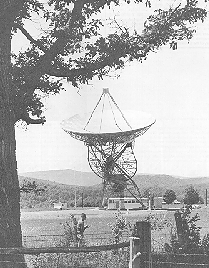
"The 85-foot telescope (was) a striking anachronism in those primitive mountains of West Virginia."
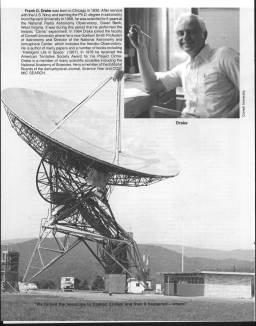
"We turned the telescope to Epsilon Eridani and then it happened — wham!"
Independently of Cocconi and Morrison, Frank D. Drake, an astronomer at the National Radio Astronomy Observatory, Green Bank, West Virginia, was formulating plans to conduct an actual search. Drake was 29 when, on April 8, 1960, he turned the 85-foot Howard Tatel telescope of the observatory toward the star Tau Ceti. Project "Ozma" had begun and for the first time man searched for signals of possible extraterrestrial intelligence. In this article Drake shares with you his feelings and emotions as the historic project progressed. It is a real-science thriller.—Eds.
Whenever I am reminded of Project Ozma, I recall how cold it is at Green Bank at four in the morning. I really have two quite vivid memories of those days — first, of the battle against the cold each morning as I would climb to the focus of the dish to tune the parametric amplifier, and then of that moment on the first day of the search when a strong unique pulsed signal came booming into the telescope just as soon as we had turned it towards the star Epsilon Eridani. But a lot of other important things happened then, and the importance of some of them wasn't apparent until years later.
Green Bank was a very exciting place in 1959. We had been given the charter, and what amounted to unlimited funds, to build the best radio observatory in the world. We had started to build a very costly telescope, the 140-foot, completion of which was still years in the future, and we knew that we really should build a smaller telescope first to get the place into operation, to gain some experience and momentum. So a contract was made to build an 85-foot telescope, and by early 1959 it stood there, a striking anachronism in those primitive mountains of West Virginia.
Ever since I was eight years old, I had wondered about the origins of people and whether there could be others elsewhere in the universe. So it was natural that one day at Green Bank I calculated just how far our new 85-foot telescope could detect radio signals from another world if they were equal to the strongest signals then generated on the earth. About ten light years, it turned out. And a few stars very much like the sun were within that distance.
The small group of scientists then at the Observatory used to have lunch together every few days at the closest thing to a restaurant, a roadside diner some five miles away which we had christened "Pierre's" or "Antoine's" although "The Greasy Spoon" was more appropriate. One snowy day in late winter we all drove down to this forlorn place and during lunch I mentioned my conclusion that we could possibly detect intelligent radio signals from some nearby stars with the new telescope. I suggested we put together some simple equipment to do the task — it took something we didn't usually use in radio astronomy, a narrow band radio receiver — and search some nearby stars for signals. At the time, the director of the National Radio Astronomy Observatory was Lloyd Berkner, a pioneer in ionospheric studies and something of a scientific gambler, and he was all for it. So as the last greasy french fry was washed down by the last drop of Coke, Project Ozma was born.
I decided we should build our equipment to operate at the 21-cm line frequency. The narrow band radio receivers to be used in Ozma would be just right to search for the Zeeman* effect in the 21-cm line of neutral hydrogen. Thus, if we set up the equipment for that wavelength, we could use it for that important experiment. In addition, it would head off any criticism that we were putting resources into the equipment wastefully. In the end we spent only about $2000 for the unusual parts of the receiver, and no one ever complained.
About that time we received a visitor on a "sabbatical" from Slough in England. His name was Ross Meadows, and as an electronics expert he was given the task of doing all the dirty work of putting the Ozma receiver together. By present standards it was a simple receiver.
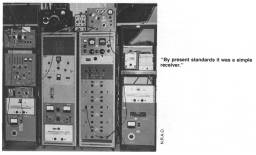 It had only one signal channel, and the simplest of outputs — a chart recorder. We also planned to have an ordinary audio tape recorder connected to the system just in case something did come in from outer space! There were some other important special aspects of the receiver. It switched between two feed horns so as to allow us to distinguish a signal from space from a terrestrial signal coming in the side-lobes of the antennas. The same approach has been used in some form in just about all the searches since. Also, there was a reference channel to which the signal channel was compared; this was a standard technique in those days and now, and was used to eliminate receiver gain fluctuations and nonlinearities. Since our bandpass was to be 100 hertz, the oscillators used in the receiver had to be a bit more stable than usual, although nothing very challenging. After a while Kochu Menon, an old friend and colleague from Harvard, came to Green Bank and worked on the receiver also.
It had only one signal channel, and the simplest of outputs — a chart recorder. We also planned to have an ordinary audio tape recorder connected to the system just in case something did come in from outer space! There were some other important special aspects of the receiver. It switched between two feed horns so as to allow us to distinguish a signal from space from a terrestrial signal coming in the side-lobes of the antennas. The same approach has been used in some form in just about all the searches since. Also, there was a reference channel to which the signal channel was compared; this was a standard technique in those days and now, and was used to eliminate receiver gain fluctuations and nonlinearities. Since our bandpass was to be 100 hertz, the oscillators used in the receiver had to be a bit more stable than usual, although nothing very challenging. After a while Kochu Menon, an old friend and colleague from Harvard, came to Green Bank and worked on the receiver also.
We had been working on this system at a relaxed pace for about six months when an important event occurred. Giuseppe Cocconi and Phil Morrison of Cornell published their deservedly famous paper in Nature in September containing the same calculations I had made, pointing out that mankind could detect other civilizations with existing radio telescopes, and suggesting the 21-cm line as the most promising band to search for signals. For a good reason — the unique status of this fundamental spectral line of the most abundant and fundamental atom of our universe, and not for the practical reason which had influenced me. It made us feel good because now there were further arguments for what we were doing.
I did not know Phil Morrison then. As a student at Cornell I had been awed by some superb lectures he gave, and he was a great help to one of my best friends, but I had never met him. He is still a superb lecturer, one of the very best, and of course one of the prime movers in SETI activities. I visited with Giuseppe Cocconi about a year ago in Geneva, where he is an active nuclear physicist at CERN.
By this time the world-renowned astrophysicist Otto Struve had become the director at Green Bank. Despite his conservative background, he was one of the few senior astronomers of that era who believed that intelligent life was abundant in the universe, and felt that everything possible should be done to support any feasible searches for signals of extraterrestrial intelligent life. So, he was for Ozma from the start, and was urging us to hurry with the project.
As an old timer in the real world of astronomy, Struve was also aware of the importance of getting credit for ideas, discoveries, and good research whenever possible. He knew it paid off in getting additional support for an institution. So, to our surprise he was very agitated and frustrated when the Cocconi-Morrison paper appeared. He was very worried that Green Bank was going to lose the credit for what he thought was an important idea. Actually, from the beginning of Ozma we had expected that any public announcement of it would bring a horde of reporters down on our heads, and so we had kept the whole thing as quiet as possible. Now Struve was very upset that we had done that. He did what he could — about a month later he was scheduled to give some prestigious lectures at MIT, and he used the occasion to ballyhoo all the activity at Green Bank in connection with the search for extraterrestrial life. The cat was out of the bag: looking back now, only good came from letting it out.
The first thing that happened was that we were offered the use of one of the first operative parametric amplifiers in the world. The realm of electronics had recently been turned topsy-turvy by two inventions — the solid-state maser,* and the parametric amplifier.* Both gave receiver sensitivities as much as ten times better than what had been in use. But both were laboratory devices, and could not be used in practice in the field on a moving radio telescope. So we were thrilled when a person who was simultaneously an avid radio ham, an intelligent life buff, and the president of one of the most sophisticated American electronic companies, Microwave Associates, offered us the use of a working parametric amplifier, probably the best in the world. This was Dana Atchley, Jr. Not only would he provide the amplifier, but he would send his chief engineer with it to install it.
On the appointed day, sure enough, I got a call in my office that the chief engineer of Microwave Associates had arrived with the amplifier. Going downstairs, I got a real jolt but kept my cool as I saw before me: 1) a British sports car, top down, made by Morgan; cars used to be made of wood and this was the last of them, you know, complete with leather straps to hold the hood down; 2) in the driver's seat, a fellow with a long flowing red beard, and wearing a red tam-o-shanter; and 3) in the passenger's seat, the parametric amplifier which had bounced all the way from Boston.
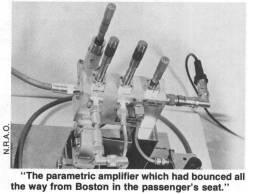 The driver was Sam Harris, known to every radio ham as a radio amateur magazine editor, and known to many and soon to me as an electronics genius. He had designed the parametric amplifier, and was the only one in the world who could make it work, and it really worked. He proceeded to install it, make it do its magic, and then taught me how to tune it, the task which became my four-o'clock-in-the-morning pick-me-up for the day. When all was well, he climbed back in his Morgan and drove off. I never saw him again until one day in 1966, I met that red beard again; this time he was on the staff of my observatory at Arecibo (I had nothing to do with this improbable event), and he has been there ever since, doing his magic.
The driver was Sam Harris, known to every radio ham as a radio amateur magazine editor, and known to many and soon to me as an electronics genius. He had designed the parametric amplifier, and was the only one in the world who could make it work, and it really worked. He proceeded to install it, make it do its magic, and then taught me how to tune it, the task which became my four-o'clock-in-the-morning pick-me-up for the day. When all was well, he climbed back in his Morgan and drove off. I never saw him again until one day in 1966, I met that red beard again; this time he was on the staff of my observatory at Arecibo (I had nothing to do with this improbable event), and he has been there ever since, doing his magic.
With much urging from Struve and Dave Heeschen, who had also come to Green Bank, to get on with Ozma, because the press and the scientific community were now harrassing us, we finally had all the equipment built in the early Spring of 1960. In April we embarked on the actual observations.
On the first day of Project Ozma, I set the alarm clock for three, got up groggily, and went out into the fog and cold which was to be my regular morning greeting for about two months. At the 85-foot telescope, the operator would turn the telescope so that I could climb into the metal can, not much bigger than a garbage can, which was at the telescope's focus. There I would sit for about 45 minutes twiddling the micrometer adjustments on the parametric amplifier, talking to the telescope operator, as we set Sam
Harris's gizmo so that it was doing the right thing. In the beginning we would have to do this several times a day as the changing temperature upset the tuning, but as time went on we found ways to evade that problem. After the amplifier was all tuned, I climbed down from the focal point, went into the control building, and set up the Ozma receiver. It was built to tune slowly in frequency so that it shifted its frequency about 100 hertz every minute.
Then we pointed the telescope at our prime target, the nearby solar-type star Tau Ceti. Once the telescope was tracking the star's position, and the receiver was set on the starting frequency, we turned on the tuning motor, the chart recorder, and the tape recorder. Project Ozma was underway!
"A strong, unique pulsed signal came booming into the telescope just as soon as we had turned it towards the star Epsilon Eridani."
Whenever you search for extraterrestrial intelligent radio signals, you always feel at the beginning that the signal may pop up right away. And so the telescope operators and I spent a breathless morning peering at the wiggling pen on the chart recorder, thinking that every time the pen started to deflect up that this was IT. Only to see the pen go down again, obeying the universal law of gaussian noise statistics. And so it went until noon, when Tau Ceti set in the west.
Then we turned the telescope to point at our second subject, the solar-type star Epsilon Eridani. It was thought to be a single star then; recently there has been evidence that it has some companions; I wish we had known that then because it would have been more exciting. Again we pointed the telescope at the star, and set up the recorders. We had also added a loud speaker so that we could hear the receiver output. Again we started the chart and tape recorders, and settled back for more of what had already become routine.
A few minutes went by. And then it happened. Wham! Suddenly the chart recorder started banging off scale. We heard bursts of noise coming out of the loudspeaker eight times a second, and the chart recorder was banging against its pin eight times a second. We had never seen anything like this before in all the previous observing at Green Bank. We all looked at each other wide-eyed. Could it be this easy? Some people had even predicted that the most rational extraterrestrial signal would be a slow series of pulses, as that would be evidence of intelligent origin. (No one had any idea about the existence of pulsars then.) Suddenly I realized that there had been a flaw in our planning. We had thought the detection of a signal so unlikely that we had never planned what to do if a clear signal was actually received. Almost simultaneously everyone in the room asked "What do we do now?" Change the frequency? Well, the most likely source of a spurious signal was the earth, and we could check that out by moving the telescope off the star and seeing if the signal went away. So we proceeded to do that, and as we moved off the star, sure enough the signal went away. So we pointed back at the star. The signal did not come back. Wow. Was it really from the star, or had it been from earth and had it turned off about the time we moved off the star? There was no way to know. And there was all that adrenaline flowing and no way to apply all that excitement and energy in a useful way.
What did we do? Day after day, as we turned to Epsilon Eridani, we tuned to the frequency on which the signal had been heard. We listened for a half hour or so, and then we would go back to our frequency scanning. We also connected a second receiver to a simple horn antenna which looked out of the control room and could pick up interference. A week went by and the signal didn't return. To our chagrin, one of our employees called up a friend in Ohio and told him about the signal. The word was passed to a newspaper reporter friend, and suddenly we were deluged with inquiries about the mysterious signal — "Had we really detected another civilization?" "No." "But you have received a strong signal with your equipment?" "We can't comment on that." And so, aha, we were hiding something. To this day many people believe falsely that we received signals from another world, and that some fiendish government agency has required us to keep this a deep dark secret.
We finally learned the truth about ten days after that BIG day. Suddenly the signals were there again, blasts of radio noise eight times a second, coming in the 85-foot telescope. But just as strongly, they were coming in the little horn we had poked out the window. The signals had to be man-made radio interference. As we watched them, we saw them grow and fade as though they were being transmitted from a high-flying passing airplane.
So we stopped listening as intently to that special frequency while the telescope was pointed at Epsilon Eridani.
The weeks went by, with hundreds of yards of chart paper and tape piling up, all with nothing but noise on them. We were now experts at scanning the records for signals. It even got dull, and I realized that as important and exciting as is a search for extraterrestrial signals, such searches
should only be done in conjunction with regular astronomical research, so that there will be real results all the time to remind the searchers that there are, after all, strange and wonderful things in the sky. So they will keep looking.
"Only by doing the best we can with the very best that an era offers, do we find the way to do better in the future."
We had some special visitors at Green Bank during Proiect Ozma, visitors who are more remarkable in retrospect than they were at the time. One who came for several days was Theodore Hesburgh, then the very young president of Notre Dame University, and an up-and coming theologian. He felt that the search for extraterrestrial life was an inspiring and a very good thing to do. He has written the forward to the most recent SETI study.
Another was John Lear, then the science editor of the Saturday Review of Literature. He was a titan among science writers — had been the first to expose abuses in the drug industry, for example. He wanted to see history made, and knew that the detection of another civilization would be HISTORY if it really happened. So he came to Green Bank, and sat quietly in one corner of the control room, watching us go through our mysterious manipulations of cables and dials, for days on end, waiting for lightning to strike. Subsequently he published some of the best discussions of the nature and importance of the search for extraterrestrial life.
A third visitor was, of all people, the vice-president for research of the Hewlett-Packard Corporation, a company which made a lot of oscilloscopes and meters and other electronic gadgets which we and every other observatory used. Bernard M. Oliver dropped out of the sky one day in a chartered plane, full of enthusiasm, to watch the goings-on in the West Virginia wilderness. Actually, as it turned out, it was not at all surprising that he was there, because he too had thought about the means for detecting other civilizations for many years. A successful inventor, electronics expert, and physicist, he already knew all about it, and was glad that someone had the opportunity at last to do something. Since then he has decided that a lot more should be done about it. Recently as the project director of the Project Cyclops Study, "Barney" Oliver has become the leader in the development of plans for enormously sophisticated systems for the detection of extraterrestrial intelligent radio signals. When he has his way, as he will some day, we will see radio telescopes ten thousand times larger than the 85-foot telescope scanning the sky, on not one, but perhaps billions of frequencies at once. Good.
After one month of searching, we took a break. Then another month, and the whole range of plausible hydrogen line frequencies had been scanned for both stars. We know that there was a chance that we had looked at the right star on the right frequency, but at a time when "Their" transmitter was turned off; so maybe a second look would hit pay-dirt. But no more telescope time could be committed to the project; there was a lot of astronomy to do. And so Project Ozma was over.
Today, with the Arecibo telescope and our 1008 channel receiver, we duplicate everything that was done in Project Ozma, actually do it better, in less than a second. And, everything is warm and cozy. But that does not mean in any way that the effort was wasted. Only by doing the best we can with the very best that an era offers, do we find the way to do better in the future. Just as Project Ozma contributed to the development of the much better systems of today, so the giant telescopes and computers of today will be replaced with even grander instruments in the future. A ladder doesn't work if some of its rungs are missing; they all have to be there, and you have to step on them all one at a time.
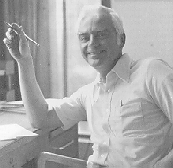 Frank D. Drake was born in Chicago in 1930. After service with the U.S. Navy and earning the Ph.D. degree in astronomy from Harvard University in 1958, he was scientist for 5 years at the National Radio Astronomy Observatory, Green Bank, West Virginia. It was during this period that he performed the historic "Ozma" experiment. In 1964 Drake joined the faculty of Cornell University where he is now [at the time the article was written] Goldwin Smith Professor of Astronomy and Director of the National Astronomy and Ionosphere Center, which includes the Arecibo Observatory. He is author of many papers and a number of books including "Intelligent Life in Space" (1967). In 1978 he received the American Tentative Society Award for his Project Ozma. Drake is a member of many scientific societies including the National Academy of Sciences. He is a member of the Editorial Boards of the Astrophysical Journal, Science Year and COSMIC SEARCH. Frank D. Drake was born in Chicago in 1930. After service with the U.S. Navy and earning the Ph.D. degree in astronomy from Harvard University in 1958, he was scientist for 5 years at the National Radio Astronomy Observatory, Green Bank, West Virginia. It was during this period that he performed the historic "Ozma" experiment. In 1964 Drake joined the faculty of Cornell University where he is now [at the time the article was written] Goldwin Smith Professor of Astronomy and Director of the National Astronomy and Ionosphere Center, which includes the Arecibo Observatory. He is author of many papers and a number of books including "Intelligent Life in Space" (1967). In 1978 he received the American Tentative Society Award for his Project Ozma. Drake is a member of many scientific societies including the National Academy of Sciences. He is a member of the Editorial Boards of the Astrophysical Journal, Science Year and COSMIC SEARCH.
* See Glossary (in a separate artticle entitled: "Miscellaneous Information from the Editors, Quotes & Graphics")
|
Little Green Men, White Dwarfs or Pulsars?
By: S. Jocelyn Bell Burnell
[Article in magazine started on page 16]
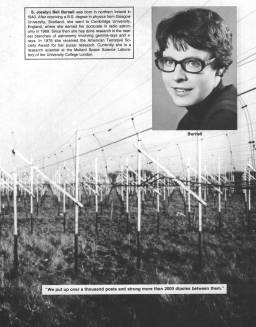
"We put up over a thousand posts and strung more than 2000 dipoles between them."
This article was presented as an after-dinner speech with the title of "Petit Four" at the Eighth Texas Symposium on Relativistic Astrophysics and appeared in the Annals of the New York Academy of Science, vol. 302, pages 685-689, Dec., 1977. Reproduced by permission.
In all the history of radio astronomy the pulsing signals discovered at Cambridge, England, in 1967 were the most suggestive of an extraterrestrial intelligent origin that have ever been detected. In this article, Jocelyn Bell Burnell tells a delightful, personal story of how she first encountered the signals and what ensued.—Eds.
Ladies and Gentlemen: Before you discover for yourselves let me tell you that I am no expert at after dinner speeches. The nearest I have come was writing a Ph.D. thesis; my supervisor kindly read a draft of it and advised me that it read more like an after-dinner speech than a Cambridge University dissertation. He was right, of course, but it has taken me years to see the funny side of his remark.
There has been a lot of interest shown in the discovery of pulsars, and also some misunderstanding. I would like to take this opportunity of setting the record straight. However, it all happened 8 or 9 years ago, and after such a time there is some difficulty in remembering it all accurately.
The story began in the mid-1960's, when the technique of interplanetary scintillation (IPS) was discovered. IPS is the apparent fluctuation in intensity of the radio emission from a compact radio source. It is due to diffraction of the radio waves as they pass through the turbulent solar wind in interplanetary space. Compact radio sources, e.g. quasars, scintillate more than extended radio sources. Professor Tony Hewish realized this technique would be a useful way of picking out quasars, and designed a large radio telescope to do this. I joined him as a Ph.D. student when construction of this telescope was about to start.
The telescope covered an area of 4 1/2 acres — an area that would accommodate 57 tennis courts. In this area we put up over a thousand posts, and strung more than 2000 dipoles between them. The whole was connected up by 120 miles of wire and cable. We did the work ourselves — about five of us — with the help of several very keen vacation students who cheerfully sledge-hammered all one summer. It took two years to build and cost about £15,000, which was cheap even then. We started operating it in July 1967, although it was several months more before the construction was completely finished.
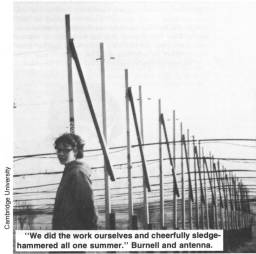
"We did the work ourselves and cheerfully sledgehammered all one summer." Burnell and antenna.
I had sole responsibility for operating the telescope and analyzing the data, with supervision from Tony Hewish. We operated it with four beams simultaneously, and scanned all the sky between declinations +50o and -10o once every four days. The output appeared on four 3-track pen recorders, and between them they produced 96 feet of chart paper every day. The charts were analyzed by hand by me. We decided initially not to computerize the output because until we were familiar with the behavior of our telescope and receivers we thought it better to inspect the data visually, and because a human can recognize signals of different character whereas it is difficult to program a computer to do so.
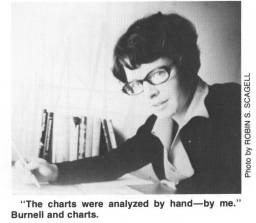
"The charts were analyzed by hand—by me." Burnell and charts.
After the first few hundred feet of chart analysis I could recognize the scintillating sources, and I could recognize interference. (Radio telescopes are very sensitive instruments, and it takes little radio interference from nearby on earth to swamp the cosmic signals; unfortunately, this is a feature of all radio astronomy.) Six or eight weeks after starting the survey I became aware that on occasions there was a bit of "scruff" on the records, which did not look exactly like a scintillating source, and yet did not look exactly like man-made interference either. Furthermore I realized that this scruff had been seen before on the same part of the records — from the same patch of sky (right ascension 1919).
The source was transiting during the night — a time when interplanetary scintillation should be at a minimum, and one idea we had was that it was a point source. Whatever it was, we decided that it deserved closer inspection, and that this would involve making faster chart recordings as it transited. Towards the end of October when we had finished doing some special test on 3C273, and when we had at last our full complement of receivers and recorders, I started going out to the observatory each day to make the fast recordings. They were useless. For weeks I recorded nothing but receiver noise. The "source" had apparently gone. Then one day I skipped the observations to go to a lecture, and next day on my normal recording I saw the scruff had been there. A few days after that at the end of November '67 I got it on the fast recording. As the chart flowed under the pen I could see that the signal was a series of pulses, and my suspicion that they were equally spaced was confirmed as soon as I got the chart off the recorder. They were 1 1/3 seconds apart. I contacted Tony Hewish who was teaching in an undergraduate laboratory in Cambridge, and his first reaction was that they must be man-made. This was a very sensible response in the circumstances, but due to a truly remarkable depth of ignorance I did not see why they could not be from a star. However he was interested enough to come out to the observatory at transit-time the next day and fortunately (because pulsars rarely perform to order) the pulses appeared again. This is where our problems really started. Tony checked back through the recordings and established that this thing, whatever it was, kept accurately to sidereal time. But pulses 1 1/3 seconds apart seemed suspiciously man-made. Besides 1 1/3 seconds was far too fast a pulsation rate for anything as large as a star. It could not be anything earth-bound because it kept sidereal time (unless it was other astronomers). We considered and eliminated radar reflected off the moon into our telescope, satellites in peculiar orbits, and anomalous effects caused by a large, corrugated metal building just to the south of the 4 1/2 acre telescope.
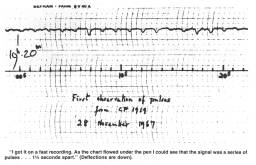
"I got it on the fast recording. As the chart flowed under the pen I could see that the signal was a series of pulses . . . 1 1/3 seconds apart." (Deflections are down).
"Were these pulsations man-made, but by man from another civilization?"
Then Scott and Collins observed the pulsations with another telescope with its own receivers, which eliminated instrumental effects. John Pilkington measured the dispersion of the signal which established that the source was well outside the solar system but inside the galaxy. So were these pulsations man-made, but made by man from another civilization? If this were the case then the pulses should show Doppler shifts as the little green men on their planet orbited their sun. Tony Hewish started accurate measurements of the pulse period to investigate this; all they showed was that the earth was in orbital motion about the sun.
Meanwhile I was continuing with routine chart analysis, which was falling even further behind because of all the special pulsar observations. Just before Christmas I went to see Tony Hewish about something and walked into a high-level conference about how to present these results. We did not really believe that we had picked up signals from another civilization, but obviously the idea had crossed our minds and we had no proof that it was an entirely natural radio emission. It is an interesting problem — if one thinks one may have detected life elsewhere in the universe how does one announce the results responsibly? Who does one tell first? We did not solve the problem that afternoon, and I went home that evening very cross — here was I trying to get a Ph.D. out of a new technique, and some silly lot of little green men had to choose my aerial and my frequency to communicate with us. However, fortified by some supper I returned to the lab that evening to do some more chart analysis. Shortly before the lab closed for the night I was analyzing a recording of a completely different part of the sky, and in amongst a strong, heavily modulated signal from Cassiopea A at lower culmination (at 1133) 1 thought I saw some scruff. I rapidly checked through previous recordings of that part of the sky, and on occasions there was scruff there. I had to get out of the lab before it locked for the night, knowing that the scruff would transit in the early hours of the morning.
So a few hours later I went out to the observatory. It was very cold, and something in our telescope-receiver system suffered drastic loss of gain in cold weather. Of course this was how it was! But by flicking switches, swearing at it, breathing on it I got it to work properly for 5 minutes — the right 5 minutes on the right beam setting. This scruff too then showed itself to be a series of pulses, this time 1.2 seconds apart. I left the recording on Tony's desk and went off, much happier, for Christmas. It was very unlikely that two lots of little green men would both choose the same, improbable frequency, and the same time, to try signalling to the same planet Earth.
Over Christmas Tony Hewish kindly kept the survey running for me, put fresh paper in the chart recorders, ink in the ink wells, and piled the charts, unanalyzed, on my desk. When I returned after the holiday I could not immediately find him, so settled down to do some chart analysis. Soon, on the one piece of chart, an hour or so apart in right ascension I saw two more lots of scruff, 0834 and 0950. It was another fortnight or so before 1133 was confirmed, and soon after that the third and fourth, 0834 and 0950 were also. Meanwhile I had checked back through all my previous records (amounting to several miles) to see if there were any other bits of scruff that I had missed. This turned up a number of faintly possible candidates, but nothing as definite as the first four.
"It is an interesting problem . . . if one thinks one may have detected life elsewhere . . . how does one announce the results responsibly?"
At the end of January the paper announcing the first pulsar was submitted to Nature. This was based on a total of only 3 hours' observation of the source, which was little enough. I feel that comments that we kept the discovery secret too long are wide of the mark. At about the same time I stopped making observations and handed over to the next generation of research students, so that I could concentrate on chart analysis, studying the scintillations and writing up my thesis.
A few days before the paper was published Tony Hewish gave a seminar in Cambridge to announce the results. Every astronomer in Cambridge, so it seemed, came to that seminar, and their interest and excitement gave me a first appreciation of the revolution we had started. Professor Hoyle was there and I remember his comments at the end. He started by saying that this was the first he had heard of these stars, and therefore he had not thought about it a lot, but that he thought these must be supernova remnants rather than white dwarfs. Considering the hydrodynamics and neutrino opacity calculations he must have done in his head, that is a remarkable observation!
In the paper to Nature we mentioned that at one stage we had thought the signals might be from another civilization. When the paper was published the press descended, and when they discovered a woman was involved they descended even faster. I had my photograph taken standing on a bank, sitting on a bank, standing on a bank examining bogus records, sitting on a bank examining bogus records: one of them even had me running down the bank waving my arms in the air — Look happy dear, you've just made a Discovery! (Archimedes doesn't know what he missed!) Meanwhile the journalists were asking relevant questions like was I taller than or not quite as tall as Princess Margaret (we have quaint units of measurement in Britain) and how many boyfriends did I have at a time?
"Look happy dear, you've just made a Discovery."
That was how my part in the proceedings ended. I finally finished the chart analysis, measured the angular diameters of a number of radio sources, and wrote my thesis. (The pulsars went in an appendix.) Then I moved out of the field to another part of the country, to get married. It has been suggested that I should have had a part in the Nobel Prize awarded to Tony Hewish for the discovery of pulsars. There are several comments that I would like to make on this: First, demarcation disputes between supervisor and student are always difficult, probably impossible to resolve. Secondly, it is the supervisor who has the final responsibility for the success or failure of the project. We hear of cases where a supervisor blames his student for a failure, but we know that it is largely the fault of the supervisor. It seems only fair to me that he should benefit from the successes, too. Thirdly, I believe it would demean Nobel Prizes if they were awarded to research students, except in very exceptional cases, and I do not believe this is one of them. Finally, I am not myself upset about it — after all, I am in good company, am I not!
All this happened 8 or 9 years ago, and to show that I operate in real time I would like to end by telling you what it is like to be on the inside in x-ray astronomy at the moment.
When I left radio astronomy and went into gamma-ray astronomy I told myself firmly that I had already had more than a lifetime's share of excitement and good luck and that I must settle down now and do some reliable and solid, undramatic science, though hopefully it would be interesting science. And certainly gamma-ray astronomy was suitably unspectacular (although I cannot help noticing how it has improved since I left the field three years ago). Then I went to MSSL and into x-ray astronomy, still telling myself that I had already had more than a lifetime's share . . . . . . . I had not appreciated that x-ray astronomy was about to boom, and had not reckoned on the excitement of participating in a satellite project in those sorts of circumstances. Life with a satellite is hectic: it never stops, nor takes holidays or weekends off — it keeps going, day in, day out. If you are not careful it runs you instead of you running it. If somebody could invent a Lord's Day Observance satellite, I would be pleased to work on it. I mentioned earlier the 3 1/2 miles of chart recordings from the radio telescope that I analyzed. The data from our experiments on Ariel V now cover 12 miles of computer printout, and the bird is still flying.
One hears about information explosions, but it is only when one happens all around you that you appreciate what it is. Within the lifetime of Ariel V — the last two years new, dramatic results have been rolling in thick and fast. X-ray transients have come to stay; many x-ray sources are found to be highly variable; periodicities on a time-scale of minutes have been discovered; more recently still x-ray bursts have opened our eyes to yet another type of phenomenon; and x-ray emission from galaxies and clusters of galaxies is now well established. What will the Universe throw at us next? There is now a thirteenth commandment "Thou shalt not make predictions in x-ray astronomy, lest the Lord thy God reveal the folly of thy ways unto all."

The pulsar discovered later in the Crab nebula blinking on and off 30 times per second.
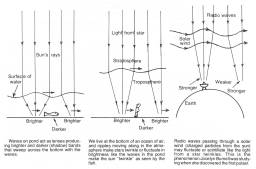
Scintillation
 S. Jocelyn Bell Burnell was born in northern Ireland in 1943. After receiving a B.S. degree in physics from Glasgow University, Scotland, she went to Cambridge University, England, where she earned her doctorate in radio astronomy in 1969. Since then she has done research in the newest branches of astronomy involving gamma-rays and x-rays. In 1978 she received the American Tentative Society Award for her pulsar research. Currently she is a research scientist at the Mullard Space Science Laboratory of the University College London. S. Jocelyn Bell Burnell was born in northern Ireland in 1943. After receiving a B.S. degree in physics from Glasgow University, Scotland, she went to Cambridge University, England, where she earned her doctorate in radio astronomy in 1969. Since then she has done research in the newest branches of astronomy involving gamma-rays and x-rays. In 1978 she received the American Tentative Society Award for her pulsar research. Currently she is a research scientist at the Mullard Space Science Laboratory of the University College London.
|
Trouble in Aquila
By: Arthur C. Clarke
[Article in magazine started on page 22]
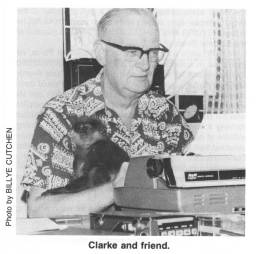
Clarke and friend
Reprinted from "The Scientist Speculates" by I. J. Good, General Editor, Copyright 1962. Capricorn Books, New York, $1.95. Reproduced by permission.
Some provocative, free-wheeling speculations about astronomical events.—Eds.
Bitter experience has made me reluctant to go into print with half-baked ideas — at least until I have a thorough discussion with a patent lawyer. For in 1945, I published a very far-out article ('Extra-terrestrial Relays', Wireless World, October 1945) in which I described in some detail the use of artificial satellites, particularly those in the synchronous or 24-hour orbit, as a solution to the problem of world communications. I never expected this idea to be baked in my lifetime; it now appears that I badly misjudged the heat of the oven.
Nevertheless, I have a few suggestions, of varying degrees of seriousness, which I am prepared to donate to the general scientific (and science-fictional) community. Some have been sitting in my writer's note-book for years, and as it now seems unlikely that I will ever use them, here they are for what they are worth — which is probably exactly nothing.
1. According to Norton's Star Atlas, there have been twenty fairly bright novae between 1899 and 1936. No less than five of them have been in one small area of the sky, in the constellation Aquila. There were two in a single year (1936), and the 1918 Nova Aquila was one of the brightest ever recorded.
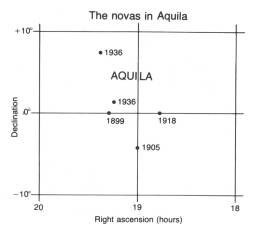 What's going on in this constellation? Why did 25 percent of the novae in a forty-year period appear in only 0.25 percent of the sky? Is the front line moving in our direction?
What's going on in this constellation? Why did 25 percent of the novae in a forty-year period appear in only 0.25 percent of the sky? Is the front line moving in our direction?
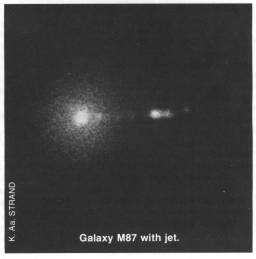 2. On the same subject, possibly. The galaxy M87 has, jutting out from its heart, a luminous jet unique in the known universe. (See article by Otto Struve, 'Virgo A', in the February 1961 issue of Sky and Telescope.) This brilliant jet, according to the Russian astronomer I. S. Shklovsky, liberates as much energy as the explosion of
10,000,000 supernovae. To provide this amount of energy it would be necessary to annihilate the mass of a hundred suns.
2. On the same subject, possibly. The galaxy M87 has, jutting out from its heart, a luminous jet unique in the known universe. (See article by Otto Struve, 'Virgo A', in the February 1961 issue of Sky and Telescope.) This brilliant jet, according to the Russian astronomer I. S. Shklovsky, liberates as much energy as the explosion of
10,000,000 supernovae. To provide this amount of energy it would be necessary to annihilate the mass of a hundred suns.
If this calculation is correct, astronomers have some explaining to do. No natural process is known - and it is hard to conceive of one - that could totally annihilate a hundred suns. Some concentrations of energy are so abnormal that they can be explained only by deliberate and intelligent planning. The explosion of an H-bomb is one obvious example: is the M87 jet, despite its stupendous scale, another? We, who have progressed from steam engines to thermonuclear reactions in a couple of centuries, should have such powers at our command in a thousand, or a million years.
Perhaps this extraordinary - indeed, unique phenomenon appeals to me because of some lines I wrote in the novel The City and the Stars (1954). If I may be allowed to quote myself:
Man was about to leave his Universe, as long ago he had left his world. And not only Man, but the thousand other races that had worked with him to make the Empire. They were gathered together, here at the edge of the Galaxy, with its whole thickness between them and the goal they would not reach for ages.
They had assembled a fleet before which imagination quailed. Its flagships were suns, its smallest vessels planets. An entire globular cluster, with all its solar systems and all their teeming worlds, was about to be launched across infinity.
The long line of fire smashed through the heart of the Universe, leaping from star to star.
In a moment of time a thousand suns had died, feeding their energies to the monstrous shape that had torn along the axis of the Galaxy and was now receding into the abyss . . .
That last paragraph might well be a description of the M87 jet. Perhaps the truth, if we ever discover it, may turn out to be even more remarkable.
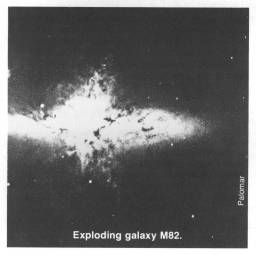
Postscript by Arthur C. Clarke written in Colombo, Sri Lanka, July 23, 1978:
This little squib was written in 1961 as a contribution to the fascinating volume "The Scientist Speculates: An Anthology of Partly-Baked Ideas", 1962, edited by Irving J. Good (Capricorn Books, New York). That was shortly before the rise of the modern Explosive Astronomy and the discovery that all hell seems to be breaking loose all over the universe.
The concept put forth in this essay is not original, and the idea that we should look for the products of "astronomical engineering" has been perhaps best expounded by Freeman Dyson. But nowhere as concisely as by Stanley Schmidt in his novel "The Sins of the Fathers" (Berkeley 1976), which contains the chilling phrase: "Seyfert galaxies are industrial accidents."
Arthur C. Clarke has written 50 books, about equally divided between fiction and non-fiction. In many SETI has been a dominant theme. Millions of copies have been printed and sold in over 30 languages. Perhaps best known is his "2001, a Space Odyssey." Other well-known ones are "Profile of the Future" and "The Promise of Space," both non-fiction, and his fiction works, "Childhood's End", "Imperial Earth" and "Rendezvous with Rama." His latest novel, "The Fountains of Paradise" is being published currently. It is about Sri Lanka from 150 AD to 4000 AD and has many SETI overtones.
A special quality of Arthur Clarke's science fiction is that it is usually so close to real science that it is difficult to distinguish the difference.
Arthur Clarke was born at Minehead, Somerset, England, in 1917. He graduated from King's College, London, with First Class Honors in physics and mathematics. He is a Fellow of the Royal Astronomical Society and a past chairman of the British Interplanetary Society and for two years (1948-50) he edited PHYSICS ABSTRACTS. Currently he is a member of the Editorial Board of COSMIC SEARCH.
In 1945, while a radar officer in the Royal Air Force, he published an article in WIRELESS WORLD which described the use of artificial satellites and, in particular, those in geostationary orbit, as a solution to the problem of world communication. This was a dozen years before Sputnik and six more years before the first successful geostationary satellite was put into orbit (1963). Now there are many such satellites forming a kind of Saturn's ring around the earth handling millions of conversations daily. In 1962 the Franklin Institute awarded their gold medal to Clarke for originating the satellite communication concept. Some of his other pioneering suggestions include the electromagnetic launcher for transporting lunar material for space enterprises and the placing of human space habitats at the stable Lagrangian libration points lying in the moon's orbit.
In 1962 he received the Kalinga Prize for science writing from UNESCO and in 1969 he won the American Association for the Advancement of Science-Westinghouse science-writing prize. His science fiction awards include the Hugo and the Nebula.
Arthur Clarke lives now in Sri Lanka, off the coast of India, with no plans to leave, unless, as he says, "there's a seat for me on the Space Shuttle." Though no longer writing, he is a voracious reader, spending "36 hours reading every 24."
|
|
The SEnTInel (SETI News)
By: The Editors
[Article in magazine started on page 25]
- SETI is Exploration
- More Stars Apt to Have Planets Says Abt
- Intelligent Life Near the Earth Unlikely; Man's Mission is to Colonize Says Shklovsky
- SETI Funding Ups-and-Downs
- United Nations Agency Promotes SETI
- Protection of SETI Frequency Bands in Jeopardy
- Bracewell Proposes Spinning Infrared Interferometer for Detection of Planets
- Holography or 3-Dimensional Mapping of Entire Universe Possible with Bold Soviet Concept for Space Telescope
- Davies Suggests That a Civilization Might Live Longer by Harnessing a Black Hole
- Space Solar Power Stations and SETI
SETI Is Exploration
Recently space probes, SETI and colonies in space have come in for criticism by a few senators, columnists and others as a waste of money which should better be spent on "more productive" things.
This attitude is not new. Explorers — those who have extended mankind's horizons — have all had their share of criticism. Columbus' expensive expedition drew censure in 1492, so did Magellan's venture of 1519 and the Lewis and Clark expedition of 1803,
which opened up the American northwest, was ridiculed because the area they planned to explore was nothing but a wasteland of rock and ice and much too far from Boston to be of any possible consequence.
Fortunately not everyone is myopic. Those who can see a little way ahead recognize (1) that our space activities are an extension of mankind, relating him to his total environment, the universe, (2) that these enterprises are non-military and have a unifying effect on all mankind as a joint endeavor, and (3) that money spent on such activities is spent right here on earth, providing many jobs that will lead to new horizons and even more jobs.
More Stars Apt to Have Planets Says Abt
Dr. Helmut A. Abt and Saul G. Levy of the Kitt Peak National Observatory have reported evidence that "the number of stars in the Milky Way galaxy (our own galaxy) that can have habitable planets circling them is much greater than previously believed." They said their finding could mean that life similar to that on earth might be much more probable among nearby stars. (This view differs from
that expressed by Josef Shklovsky as reported elsewhere in the SEnTInel in this issue of COSMIC SEARCH.)
Dr. Abt said that they had found evidence that hot stars, as well as cooler stars like our sun, have companions orbiting them which must be planets.
The astronomers are trying to find out what fraction of different type stars have companions. In a 1976 study, they concentrated their efforts on stars that are like the Sun. Using the telescope at the Kitt Peak National Observatory, the scientists surveyed 123 stars to look for orbital motions, an indication that they are being affected by the gravitational force of an unseen companion. They
found that one tenth of the 123 stars had companions that were too small to be other stars yet large enough to cause orbital motions. They concluded that these companions must be planets.
In their most recent survey, just completed, the scientists used the same technique to search for companions of hot stars. They found that of 42 star systems studied, seven — or about 16 percent — may have planets circling them.
"These results imply that for most types of stars, companions of some sort are present in most or all cases and that these companions may be planets in 10 to 20 percent of the cases," Dr. Abt said. "Other companions could be other stars. From here we need to conduct intensive searches with new ultra-sensitive equipment to measure small Doppler shifts or to listen with radio telescopes for radio signals from planets around candidate stars."
Dr. Abt estimated that of the approximately 100 billion stars in the Milky Way, probably 10 billion could have planets orbiting them. "But," he added, "we don't know what fraction of these are habitable."
Also since hot stars are not as long-lived as cooler ones, higher forms of life may not have time to evolve on any planets associated with them.
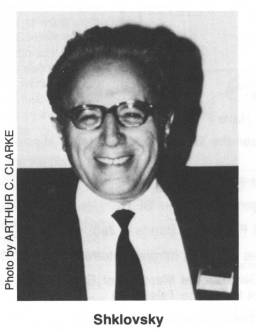
Intelligent Life Near the Earth Unlikely; Man's Mission Is to Colonize Says Shklovsky
Professor Josef Shklovsky of the Soviet Academy of Sciences believes that the chances of finding extraterrestrial intelligent life are extremely remote. Writing in a recent issue of "Social Sciences" he expressed the opinion that the sun with its planets is a rare exception in the stellar world, and that the nearest extraterrestrial civilization is probably at least 10,000 light years distant. He argues that the apparent absence of intelligent life within the earth's vicinity should not discourage, but rather spur, the conquest of space. He contends that expansion into space by mankind is inevitable and will provide a long-term solution to mankind's
population and environmental problems. He foresees artificial biospheres in space capable of supporting billions of people within several hundred years.
Almost 100 years ago the Russian writer Konstantin Tsiolkovsky proposed manned space stations with artificial gravity and a closed ecological system. Over the years others, including Herman Noordung, Wehrner von Braun, Arthur C. Clarke, Darrell Romick, J. D. Bernal and Freeman Dyson, have elaborated and expanded on the concept. Recent proposals similar to Shklovsky's have been made by
Professor Gerard K. O'Neill of Princeton University who regards space as mankind's" high-frontier". ("The High Frontier" is the title of Professor O'Neill's new book on the subject.)
SETI Funding Ups-and-Downs
Included in the NASA space budget for Fiscal Year 1979 was a $2 million request for multi-channel SETI receivers and their application by the Jet Propulsion Laboratory of the California Institute of Technology. On May 4, 1978, a U.S. House of Representatives appropriations subcommittee recommended that the $2 million be reduced to $600,000. The $2 million F.Y. 1979 request was part of a $15 million NASA SETI proposal for the next 7 years. This proposal had been chosen instead of an earlier more limited one from the NASA-Ames Research Center for about $6 million over a 7 year period.
Subsequently, the amount was reduced to zero by a Senate committee. The magazine SCIENCE, published weekly by the American Association for the Advancement of Science, commented in the June 2, 1978 issue that the setback of the SETI plans is a "sharp example of scientists failing when it comes to imbuing legislators with their own enthusiasm. Support for the (SETI) project is remarkably widespread among astronomers as well as other scientists who consider the investment tiny in view of the potential gains".
But the SETI proposals are not alone in being slated for cuts. NASA's Space Telescope which could provide man's clearest view of the universe may be in for a very substantial cut and the Galileo Mission to Jupiter may also receive reduced funding. These cuts are manifestations of a general decline in research and development efforts by the United States in recent years while such efforts continue to rise in other countries notably the U.S.S.R., Japan and West Germany according to a report by the National Science Board issued by the National Science Foundation. The number of persons engaged in research and development in the U.S.S.R. is now double that in the U.S.
United Nations Agency Promotes SETI
May 17, 1978, was "World Telecommunications Day" as designated by the International Telecommunications Union (I.T.U.), a Geneva-based
agency of the United Nations.
In a New York Times article, "U.N. Agency Promoting Search for Civilizations on Far Worlds", Walter Sullivan wrote,
"Many astronomers and other scientists believe that civilizations more advanced than that on the earth may live on the planets of other stars. In promoting the search for evidence of such technologies, the Telecommunications Union cited a report which assessed the extent to which the earth's own television signals might be detectable by civilizations with equipment no more sensitive than that on this planet.
"It was concluded that such detection was possible if the antennas were on any planet orbiting one of the 300 nearest stars. Such reasoning has led radio astronomers to propose looking for similar signals."
In dedicating this day to promoting the search for extraterrestrial life, the Telecommunications Union summarized American, Canadian and Soviet detection efforts. It reported that astronomers of its member countries, using "the largest and most sophisticated modern radio telescopes" had failed to pick up any signals.
"This may mean that either nobody is out there or that perhaps the astronomers are listening on the wrong frequency", it suggested.
"Many astronomers engaged in the search for extraterrestrial intelligence" the I.T.U. statement said, "argue that the exchange of scientific and technical information would be of inestimable benefit both to us and them."
Proponents of the search, it continued "argue that it has a sound scientific base, pointing out that it is just as ridiculous to assume there is nothing out there as it is to state, without proof, that the universe is teeming with life."
The statement cited the debate on whether detection of signals should be kept secret to avoid public panic and whether any reply should be withheld to avoid attack from afar.
"A much more positive approach," it said, "would be to consider the spiritual and philosophical benefits that would result from such an exchange of knowledge, leading to a new respect and humility if we found that man was not alone in the universe."
INTERSTELLAR MOLECULES
Dozens of molecules have been detected by radio telescopes in the almost but not quite empty space between the stars of our galaxy. Their complex structure suggests that outer space may contain even more complex types, including forms basic to life. In many cases the amounts found are enormous. A few interstellar molecules are listed in the table.
| Molecule | Formula | Wavelength
(millimeters) |
| Hydroxyl radical | OH | 180 |
| Water | H2O | 2 and 14 |
| Ammonia | NH3 | 13 |
| Carbon monoxide | CO | 2.6 |
| Hydrogen sulphide | H2S | 1.8 |
| Formaldehyde | H2CO | 62 |
| Hydrogen cyanide | HCN | 3.4 |
| Methyl alcohol | CH3OH | 3.5 |
| Silicon monoxide | SiO | 2.3, 3.4 and 6.9 |
Data after G. Winnewisser, Naturwissenschaften, 1975, page 200.
Protection of SETI Frequency Bands in Jeopardy
The Federal Communications Commission (FCC) issued a Notice of Inquiry (NOI) No. 8 in May requesting comment on the proposed United
States negotiating position for the 1979 World Administrative Radio Conference (WARC). The conference meets every 20 years so member nations, numbering 150, can decide on the allocation of channels throughout the radio spectrum.
Dr. Frank D. Drake of Cornell University has urged radio astronomers and others around the world to write their governments requesting that the 1400 to 1727 megahertz band be allocated to SETI. The band is now shared by radio astronomy with taxis, fire engines, ships, aircraft and satellites.
The NOI includes a footnote (No. 351) which states in part,
"Administrators should bear in mind that passive (SETI research) is being conducted in various parts of the spectrum . . . with particular emphasis on the band from 1400 to 1727 megahertz when searching nearby stars. Reason: They may help us."
In a letter to the FCC dated June 13, 1978, Dr. Mark Stull, a California radio-astronomy attorney, pointed out that the footnote is insufficient since it carries with it no mandatory protection of the 1400 to 1727 megahertz band. The band extends between the
hydrogen and hydroxyl frequencies and is often called the "water hole" band. It is the opinion of many scientists that this band is likely to be used by extraterrestrial civilizations to attract the attention of emerging technological societies such as our own.
Our transmitters may make extraterrestrial civilizations aware of us but if we have no clear channels on which to listen we will never be aware of them.
Stull maintains that the public interest in SETI is so strong that the band should be protected by regulating any transmitters using the band and by the complete prohibition of all satellite transmitters from the band because receivers on the ground are extremely vulnerable to a transmitter in the sky. However, Stull notes that many low power uses of the band are compatible with SETI provided the transmitters are not in satellites.
Scientists and others interested in SETI will, no doubt, agree with Drake and Stull. If hearings are held SETI supporters can help by writing the FCC.
Bracewell Proposes Spinning Infrared Interferometer for Detection of Planets
In a recent report Professor Ronald Bracewell of Stanford University has proposed using an interferometer operating at infrared wavelengths so deployed that a null of its response pattern would be held on a target star while the interferometer rotated, allowing its response pattern to sweep the regions around the star for planets. Although stars with planetary systems may be common in the
galaxy there is no incontrovertible evidence yet of any planetary systems save our own.
The interferometer might consist of two one-meter mirrors with a separation or baseline of about 8 meters.
A basic problem in detecting a planet is that the star it is orbiting will be enormously brighter. It's like trying to see a firefly next to an automobile headlight from a distance of several kilometers. Bracewell's proposal enhances the probability of detecting a planet because (1) the planet, being cooler than the star, is relatively stronger in the infrared than in visible light and (2) the star's effect is minimized by placing it in a null or blind spot of the interferometer.
Holography or 3-Dimensional Mapping of Entire Universe Possible with Bold Soviet Concept for Space Telescope
In a recent report of the Academy of Sciences of the USSR's Space Research Institute, 23 Soviet scientists including N.S. Kardashev and I.S. Shklovsky, have proposed a radio telescope of remarkable characteristics. The report entitled the "Infinitely Built-Up Space Radio Telescope" envisions telescopes up to 10 kilometers in diameter assembled from many smaller modules of 200 meter diameter. The problems of delivering, assembling and aligning the modules in orbit are discussed. It is further proposed that two or more such telescopes be arrayed as an interferometer with a 20 astronomical unit baseline. This would involve placing the telescopes at approximately the orbit of Saturn. With such an interferometer operating at wavelengths of a few centimeters the entire universe lies within what is called the "near-field" or "Fresnel zone" of the antenna. What this means is that, in principle, it would be possible to determine the distance, size and shape of every observable object in the universe, producing holographic or 3-dimensional figures
of the entire cosmos. This proposal is a bold concept which indicates that radio astronomers are still far from the end of their tether.
The authors of the report point out that such a system could also be used to advantage for the detection of extraterrestrial civilizations (SETI). For example, planets the size of the earth could be detected from their thermal radiation alone at distances of 100 light years and planets like Jupiter at 1000 light years. Artificial radiation might be detected at much greater distances, possibly bringing millions of planets within range.
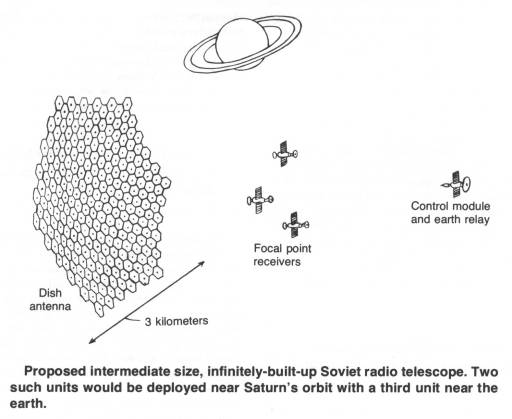
Davies Suggests That Civilizations Might Live Longer by Harnessing a Black Hole
In a recent book "The Runaway Universe," Dr. Paul Davies of King's College, London, considers how a super-technology might "tame" a
black hole to supply the energy needed to extend its lifetime over periods much longer than enjoyed by the stars. In fact, "the epoch of the stars may come to be regarded by these extraordinary inhabitants of the future as merely a primeval phase — a brief
interlude at the dawn of history."
Space Solar Power Stations and SETI
To harness the sun's power it has been proposed that space stations with huge solar panels be placed in orbit. Far above the earth's atmosphere, they could gather energy regardless of cloud conditions. The energy collected would be converted into microwaves, beamed to the earth, gathered by big antennas, reconverted to ordinary 60 hertz electrical power and fed into existing power distribution systems. The orbiting collecting panels of a space station might be many square miles in area with even larger receiving antennas covering hundreds of square miles on the earth.
Opponents of the system point out that, aside from the enormous cost running into tens of billions of dollars, the scheme would make our already big, centralized bureaucratic power system even more unwieldy and even more vulnerable to massive disruptions from mechanical or electrical failures, sabotage or enemy action. How much atmospheric heating would the microwave beam produce and would this heating have undesirable effects? Would plant and animal (including human) life at or in the vicinity of the earth antennas be adversely affected? And might a whole city get fried if the microwave beam were accidently misdirected? Quantitative answers are needed to these questions.
Radio astronomers and SETI observers are concerned because all satellite transmitters are potential sources of interference of the worst kind since they can beam directly down into the super-sensitive earth-based telescopes. It is bad enough to have transmitters of 1, 10 or even 100 watts power on such satellites but the millions and billions of watts from a space power station could be devastating.
An alternative approach to harnessing the sun's power is to have large numbers of moderate-sized ground based solar and wind collectors associated with single factories, buildings and individual homes resulting in a highly decentralized arrangement. This approach would be much less vulnerable overall because it would be ground-based, power transmission over long distances would be reduced or eliminated and collecting units would be widely dispersed. It is argued that the decentralized approach could result in the development of many new businesses and a stimulus for older ones over a wide spectrum of technologies. It is pointed out that
solar power is already distributed world wide to everyone's doorstep free at the level of 4 million watts per acre (perpendicular to the sun). Efficient collection and storage are considered no greater problems than the collection, conversion to microwaves, transmission of microwaves, their collection, reconversion and further transmission in the case of the space collector concept.
The space collector approach is being promoted by the Sunsat Energy Council, representing a group of aerospace firms and other organizations. Hearings were held before a U.S. House of Representatives science subcommittee in May, 1978 on a bill to authorize the expenditure of $25 million on the concept during the next fiscal year.
Quote from Eric Burgess (Space Age Review)
"If we do find extraterrestrial civilizations we will find that they have probably broken away from all our traditional ways of doing things if they have managed to survive through the nuclear age.
"If we don't break with our traditions, we are not going to survive. We are coming to a very critical point in our development where we either do something or perish." Eric Burgess in Space Age Review.
|
Rendezvous with Infinity
By: Norman Cousins
[Article in magazine started on page 30]

A humanist's view of SETI and the cosmos by a master
wordsmith in the manner of a Socrates.—Eds.
What priority should we, as a nation, give to satisfying our cosmic curiosity about extra-terrestrial intelligence? Can the American people hope to realize gains — for ourselves and humankind — that will justify the expense? These questions might easily be dismissed if there were no connection between curiosity and civilization. Human progress begins with the words "what if." The desire to know and to pursue a line of thought is not a random quality of mind, but the genesis of science.
It is unscientific to say that within the many billions of galactic systems, ours is the only planet that supports life in advanced form. Nature shuns one of a kind as much as it abhors a vacuum. Given infinite time and space, anything that occurs at one place or time in the universe will occur elsewhere or "elsewhen." The same conditions that make life possible make life inevitable. The interaction of these conditions forces life into being. So long as the interaction continues, life will persist or recur. The possible becomes the inevitable when there are no limits on the laws of chance.
"As we move beyond the human habitat, we are gaining perspective on ourselves as custodians of the planet."
Many will argue that the problems that threaten life here on earth should have first claim on our resources. What this argument fails to take into account is the fact that the future of humankind may well depend upon an enlargement of the human horizon. The most crucial problems that confront us stem from our limited perception of ourselves as a people within the human community.
Human beings have yet to experience what it means to be full-fledged members of the family of man. Though we give intellectual and reverential assent to the idea of human brotherhood, we have only partially engaged the imagination and spirit that can give the idea meaning. Our overriding problems have to do with human behavior and the value we assign to life in general.
"We belong to an unfinished species . . . our uniqueness lies in our ability to steer our own evolution."
The justification for exploring the cosmos rests not on tangible benefits, but on philosophical grounds and on our instinctive need to evolve. From the time of Copernicus, the collective ego has been trying to adjust to the discovery that the earth is not the hub of the universe. The psychological adaptation to that reality is still in process. We will come of age as a cosmic species when we make peace with the fact that although the universe is not constructed for our particular benefit and convenience, sentient life is sufficiently rare in the universe to make life precious.
It is reasonable to believe that cosmic curiosity akin to our own is signaling its existence across stellar space, and that with sophisticated new systems we can winnow these signals from the already-detected "noise" that may be originating from beyond our solar system. It is reasonable to believe that the filtering of these signals from out of the cosmos could contribute vastly more to our future security than instruments of mass annihilation.
New perspectives lead to new perceptions. As we enlarge our sense of the cosmos, we are enlarging our consciousness.
As we extend the reach of the mind, we are learning more about our potentialities. As we move beyond the human habitat, we are gaining perspective on ourselves as custodians of the planet. It is precisely because our human habitat is in jeopardy that we need to think and act on a universal plane rather than as members of hostile tribes.
What was most significant about the first lunar voyage was not that men set foot on the moon, but that they set eye on earth. The scrapings from the surface of the moon brought back to earth — significant as they are — are not as significant as the perceptions carried back in our minds. Perspective continues to be man's greatest shortage.
"What was most significant about the first lunar voyage was not that men set foot on the moon, but that they set eye on the earth."
We belong to an unfinished species. We have limitless capacities for growth. Indeed, our uniqueness lies in our ability to steer our own evolution. It is reasonable to believe that the search for extra-terrestrial intelligence will contribute significantly to the solving of our problems here on earth. Anything that ignites the human mind, anything that sets the collective intelligence to racing, anything that creates a new horizon for human hopes, anything that helps to enlarge our vocabulary of common heritage and common destiny — anything that does this is of incalculable value. A generation raised with the knowledge that intelligent life in another galaxy may have found answers that assure the immortality of their species will have a heightened awareness of the potential of terrestrial intelligence.
Throughout much of human history, man has sought to make connections with the heavens, to establish and to understand his place in the universe. It is reasonable to believe that the future of the human race may depend upon keeping the rendezvous with infinity foretokened by man's earliest attempts to link his fate to celestial glimmerings.
Norman Cousins has been associated with the "Saturday Review" as editor or chairman of the editorial board for almost four decades. Born in Union Hill, New Jersey, he attended Columbia University, wrote for a New York newspaper and was managing editor of "Current History Magazine" for five years prior to joining the "Saturday Review" in 1940 at the age of 25. Dr. Cousins is the recipient of dozens of honorary degrees, numerous citations and awards including the United Nations Peace Medal (1971), author of many books including "Modern Man is Obsolete" (1945) and "Talks with Nehru" (1951) and editor of several more, one of which is "Doctor Schweitzer of Lambarene" (1960).
He is a member of the Editorial Board of COSMIC SEARCH and currently Adjunct Professor at the School of Medicine at the University of California at Los Angeles where he is affiliated with the Brain Research Institute and where he is lecturing on the role of the humanities in the training of medical students. Concurrently he is Advisory Editor of the journal "Man and Medicine" and a member of the task force on medical ethics at the College of Physicians and Surgeons of Columbia University.
|
|
ABCs of SETI
By: John Kraus
[Article in magazine started on page 32]
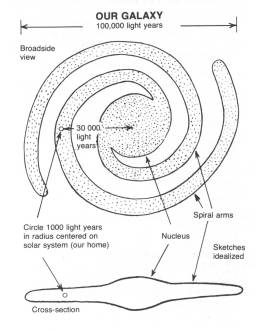 To appreciate the full significance of searching for extraterrestrial intelligence we must shift our thinking far beyond our solar system to other stars of our galaxy and even galaxies beyond our own. As a first step, in this issue, let's consider our own galaxy and how we relate to it.
To appreciate the full significance of searching for extraterrestrial intelligence we must shift our thinking far beyond our solar system to other stars of our galaxy and even galaxies beyond our own. As a first step, in this issue, let's consider our own galaxy and how we relate to it.
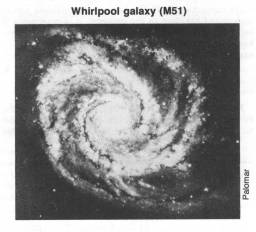 Our galaxy is an aggregation of perhaps 100,000 million stars arranged like a flat wheel or disc 100,000 light years
across, turning around once in about 300 million years. It has a nucleus with spiral arms radiating from it as suggested by the accompanying sketch (to the right). It may not look too different than the Whirlpool galaxy (M51) in the photograph alongside (to the left). The stars are more numerous in the spiral arms than between them and even thicker in the nucleus. It is believed that a cross-section would appear similar to that of the galaxy (NGC 4565) in the photograph (below).
Our galaxy is an aggregation of perhaps 100,000 million stars arranged like a flat wheel or disc 100,000 light years
across, turning around once in about 300 million years. It has a nucleus with spiral arms radiating from it as suggested by the accompanying sketch (to the right). It may not look too different than the Whirlpool galaxy (M51) in the photograph alongside (to the left). The stars are more numerous in the spiral arms than between them and even thicker in the nucleus. It is believed that a cross-section would appear similar to that of the galaxy (NGC 4565) in the photograph (below).
We (that is the sun, the earth and the sun's other planets) are situated in a spiral arm some 30,000 light years from the center of the galaxy or about two-thirds of the way from the center to the edge — in the galactic boondocks or outback. The little circle at our location in the two sketches has a radius of 1000 light years. Within a sphere of this size there are about one million stars. A sphere of 1000 light year radius is really enormous yet it constitutes less than one-hundredth of one percent of our galaxy! And beyond our galaxy are some 100,000 million more galaxies.
Summary:
- Stars have planets (at least one star, the sun, does).
- Galaxies have stars.
- Our galaxy is a flat disc (100,000 light years in diameter).
- Our galaxy turns around once in 300 million years.
- We are located 2/3 of the way to the edge of our galaxy in a spiral arm.
- A sphere 1000 light years in radius occupies a very small part of our galaxy (0.01 of 1 percent).
- There are about 100,000 million (1011 or ten to the eleventh power) stars in our galaxy.
- There are about 100,000 million (1011 or ten to the eleventh power) galaxies in the universe.
- Therefore, there are about 10,000 million million million (1022 or ten to the twenty second power) stars in the universe.
- Within 1000 light years of the sun there are about one million stars and perhaps 1/5 of these are sun-like (similar in age, size and composition and may have planets).
- Notes:
- One light year equals the distance light travels in one year (300,000 kilometers times the number of seconds in a year or about 1013 or ten to the thirteenth power kilometers).
- M51 stands for object number 51 in the list of Charles Messier, a French astronomer (1730-1817).
- NGC4565 stands for object number 4565 in the New General Catalog of astronomers. J. L. E. Dryer [sic; Dreyer] (1852-1926) of Denmark and Great Britain.
Our universe began to form about 15,000 million years ago with the explosion of a primorial [sic; primordial] fireball (The Big Bang). The Cosmic Calendar lists events that have occurred since that time. We note that our advanced technology (even mankind for that matter!) has only been around for a very short time. It is apparent that we are a very young, emerging civilization.
Light, radio or other electromagnetic waves travel 300,000 kilometers per second in empty space. This is the top speed at which anything can travel. We can express astronomical distances using this velocity. See Distance
Table. Thus, the distance to the moon in light travel time is about one second, to the nearest star (other than the sun) about 4 years and to the limit of our universe about 15,000 million years.
The waves (light or radio) from some galaxy 2 million light years distant (same as 2 million years light-travel time) are 2 million years old when they get here. This means we see or observe the galaxy as it was 2 million years ago. Like cosmic archeologists, we are looking back in time 2 million years. The farther out we look the farther back in time we see. Thus, in a very real sense time and distance are closely inter-related.
Age of universe (T) = 15 billion years
Radius of universe (R) = 15 billion light years
R = cT
where c = velocity of light
= 300,000 kilometers per second
|
Summary:
- The universe is 15,000 million years old.
- Our technological civilization is very young.
- The farther out we look the farther back in time we see.
- Time and space are inter-related.
|
How likely is it that there are other civilizations in our galaxy capable of communication? If you consider all of the factors you can write a simple relation, as done by Frank Drake, for estimating the probability. I use the word "estimate" intentionally because our knowledge of most of the factors is so poor that we are really only guessing. Your guesses may be as good (or bad) as the next person's so why not play the probability game and see what number you come up with?
The relation, known as Drake's Equation, involves 7 factors as follows:
|Number of | |Rate | |Fraction| |Number | |Fraction|
|civilizations| |of | |of stars| |of | |of |
|in our galaxy| |star | |with | |planets | |planets |
|capable of | = |formation| X |planets | X |per star| X |on which|
|communiaction| |(per | |with | |life |
|now | |year) | |suitable| |appears |
|environ-|
|ment |
|Fraction| |Fraction | |Longevity |
|of life | |of | |of each |
|bearing | |intelli- | |technology |
x |planets | X |gent | X |in |
|on which| |societies| |communi- |
|intelli-| |which | |cative |
|gence | |develop | |mode (years)|
|emerges | |communi- |
|cation |
|ability |
Worked Example:
|Number of | |1 |
|civilizations| |per |
|in our galaxy| = |year| X 1/5 X 2 X 1 X 1 X 1/10 X 1000 = 40
|capable of |
|communication|
|now |
|
Suppose you guessed that stars in our galaxy form at the rate of one per year (probably not a bad estimate), that 1/5 of the stars have planets (no one knows), that there are 2 planets with stable environments (a guess), that life appears on each (fraction = 1), that intelligence emerges on each of these (fraction = 1), that 1/10 of these develop communication capability and that these remain in this state for 1000 years. Then, it works out that the number is 40 (as above).
According to this estimate, there would be 40 civilizations in our galaxy capable of communication, or about one per trillion (1012 or ten to the twelfth power) cubic light years so that the nearest one might be something like 10,000 light years away.
However, if it is in a communicative mode for only 1000 years, as assumed, it will be extinct long before its signals are received at the earth. The longevity time (last factor) is very uncertain. Is it 10 years or one million? In this example we have assumed 1000 years.
Now, you play the SETI game by writing down your numbers. Who knows? Your result may be the right one.
Summary:
- The SETI probability numbers are very uncertain because in all the universe we know of only one example of a civilization, us!
Even if we believe that there may be other civilizations, in which direction should we look and, if we use radio, on what wavelength (or frequency) should we listen? Let us answer the last part of this question now, leaving the rest for a later issue.
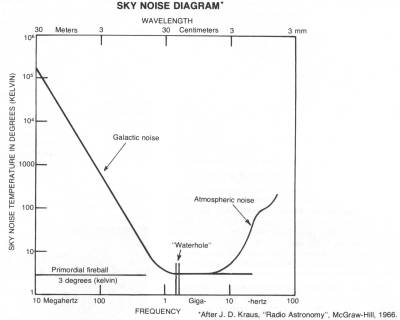 The most abundant element in the universe is hydrogen (H). It emits a natural radio signal, called the hydrogen line, at a wavelength of 21 centimeters (or frequency of 1420 megahertz). An advanced extra-terrestrial civilization would certainly be aware of this hydrogen radiation and if they chose to attract attention to themselves with a beacon signal they might choose to use this wavelength or one close to it. Also 21 centimeters is near a minimum of the background noise from the galaxy (and beyond) and is
relatively free of absorption by the interstellar medium and by our atmosphere and the probable atmosphere of other planets (see Sky Noise Diagram to the right). Therefore, a beacon should be detectable at a greater distance at 21 centimeters or thereabouts. This is the general line of reasoning used by Cocconi and Morrison in 1959 (see lead article of this issue).
The most abundant element in the universe is hydrogen (H). It emits a natural radio signal, called the hydrogen line, at a wavelength of 21 centimeters (or frequency of 1420 megahertz). An advanced extra-terrestrial civilization would certainly be aware of this hydrogen radiation and if they chose to attract attention to themselves with a beacon signal they might choose to use this wavelength or one close to it. Also 21 centimeters is near a minimum of the background noise from the galaxy (and beyond) and is
relatively free of absorption by the interstellar medium and by our atmosphere and the probable atmosphere of other planets (see Sky Noise Diagram to the right). Therefore, a beacon should be detectable at a greater distance at 21 centimeters or thereabouts. This is the general line of reasoning used by Cocconi and Morrison in 1959 (see lead article of this issue).
There is also natural emission from the hydroxyl (OH) radical at 18 centimeters. Now if you combine hydrogen (H) with the hydroxyl radical (OH) you get water (H2O), so the wavelength region between 18 and 21 centimeters is often referred to as the "waterhole", in further allusion to the fact that galactic civilizations might (like radio amateurs) gather around this "waterhole" to chat like different species of animals gather around an African waterhole to drink.
Summary:
- Interstellar hydrogen (H) emits at 21 centimeters.
- Interstellar hydroxyl (OH) emits at 18 centimeters.
- The wavelength region between 18 and 21 centimeters is called the "waterhole".
- Many SETI searches are made in the "waterhole".
Notes:
Waterhole wavelengths:
- Hydrogen line (H): 21.1 centimeters (1420 megahertz)
- Hydroxyl lines (OH): 18.3 centimeters (approximately 1638 megahertz)
In the next issue of COSMIC SEARCH the above topics will be pursued further and other facets of SETI will be considered. Many books for further reading are listed in "Off the Shelf" (elsewhere in this issue). The ones by Drake, Sagan, and Sullivan are good as an introduction.

|
|
Time and a Cosmic Perspective
By: Richard Berendzen
[Article in magazine started on page 36]
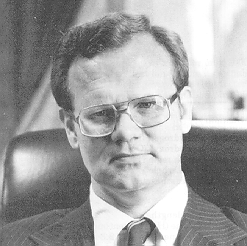
A beautiful thumbnail description of the evolution of the
universe and of its significance to mankind.—Eds.
Time. We kill time, spend time, lose time, make time, beat time, take time, waste time; but we virtually never consider time, much less understand it. Yet to view events properly and possibly even to perceive ourselves in rightful context, let us go back in time, even to its beginning.
For countless ages there truly was darkness on the face of the deep. Then, some 18 billion years ago, a cataclysmic explosion brought forth the cosmos itself. This was the birth of the universe. Even today we live in the lingering remnant of the radiation produced by that titanic blast. Some billions of years after the explosion, large ensembles of material clumped because of their mutual attraction. And so the protogalaxies were born. In those early galaxies, some of the gas and dust congealed by its own gravity to form large, amorphous, spherical balls, which slowly shrank and ultimately flickered into light. And so the stars were born. In the hearts of those stars, nuclear furnaces raged. In a form of stellar alchemy, hundreds of millions of tons of hydrogen were converted into helium every second. And so they have burned for all these billions of years.
"Without astronomy we could not understand this epic, this cosmic perspective."
As the stars formed, debris was left behind. Some of it became planetary systems around the stars. On some of those planets there must have been early atmospheres, perhaps similar to the earth's in its primordial days. In some of those atmospheres there must have been the very chemicals that brought forth life here. All current evidence
compellingly suggests that the same processes that operated here might well have operated elsewhere, possibly thousands or millions or even hundreds of millions of times. If so, life may have flickered into existence on those planets, and some of that life may have been intelligent.
Billions of years went by, with galaxies forming and stars burning, expanding, exploding, shrinking, collapsing, dying. Then, some five billion years ago, on the remote periphery of an average galaxy in an unexceptional part of the universe, a particular star was born. On piece of debris number 3, special events were to take place; several billion years later the chemical and biological processes of that young planet's atmosphere and oceans yielded a strange new apparition — Homo sapiens, man.
After more eons elapsed, man evolved, creating societies and civilizations and education and nations and war and peace and law and science and technology and our modem world. And here we are in the year marked in time as 1979.
In such a cosmic sweep through space and time, any rational person must feel an almost overpowering smallness. Our day-to-day concerns and trite prejudices shrink into microscopic, infinitesimal nothingness.
Yet there is another side, and it gives dignity and worth to life itself For even though our physiques are but specks in space and our life-spans but ticks in time, we nonetheless are capable of comprehending a system far vaster than ourselves. Our ethical and moral concerns, together with this ability, constitute some of the most ennobling characteristics of humankind.
Without astronomy we could not understand this epic, this cosmic perspective. And it is worth knowing.

This piece appeared at the conclusion of a longer article "Out of Sight." Reprinted by permission from THE AMERICAN SCHOLAR, Vol. 46, No. 4, Autumn 1977. Copyright 1977 by the United Chapters of Phi Beta Kappa.
Richard E. Berendzen was born in Walters, Oklahoma, in 1938. He received a Ph.D, degree from Harvard in 1967. Joining the physics faculty at Boston University, he became department chairman in 1971. Three years later he went to the American University, Washington, D.C., where he is now University Provost. Dr. Berendzen is the author of several books including "Man Discovers the Galaxies" (1975). Currently he is a member of the Editorial Board of COSMIC SEARCH.
Dr. Berendzen believes that science fact, if presented well, can be far more engaging than science fiction. He feels that there is a tremendous need to make more people aware of the difference between real science and blatant pseudo-science.
|
|
What If We Succeed?
By: Walter Sullivan
[Article in magazine started on page 37]
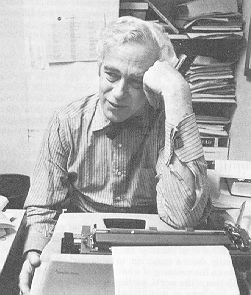
A fascinating analysis of the search for extraterrestrial intelligence and its relation to our hopes, fears and religious beliefs.—Eds.
The basis for the existence of this magazine and, I assume, the mutual conviction of all those on its editorial board is that seeking out and exchanging information with extraterrestrial intelligence is a supremely worthwhile goal. Yet this view is not shared by everyone. George Wald, professor of biology at Harvard, winner of a Nobel Prize, and himself a firm believer that life has probably evolved in many regions beyond the earth, has said: "I can conceive of no nightmare so terrifying as establishing such communication with a so-called superior (or if you wish, advanced) technology in outer space."
Most of us believe that we would stand to benefit enormously from communication with another civilization. Since our rate of technological advance is so rapid (and, presumably, the same applies to other civilizations), the technology with which we make contact is almost certain to be far more advanced than ourselves. If they lagged behind us, they could not communicate, and it is highly unlikely that they would happen to be just at the transitory stage in which we find ourselves.
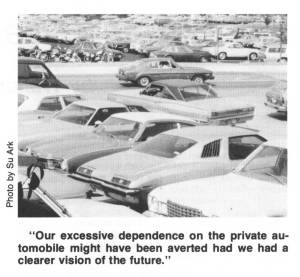 Ever since Cocconi and Morrison proposed a rational way to seek out signals from another world, Morrison himself and many others have cited what an enriching experience it would be for humanity to learn of the histories, political and economic organizations and cultural achievements of entirely different civilizations. Such knowledge could enable us to leap into the future, avoiding the pitfalls that have hampered our progress in the past. Our excessive dependence on the private automobile, which has made us dangerously vulnerable to fuel shortages, might have been averted had we had a clearer vision of the future.
Ever since Cocconi and Morrison proposed a rational way to seek out signals from another world, Morrison himself and many others have cited what an enriching experience it would be for humanity to learn of the histories, political and economic organizations and cultural achievements of entirely different civilizations. Such knowledge could enable us to leap into the future, avoiding the pitfalls that have hampered our progress in the past. Our excessive dependence on the private automobile, which has made us dangerously vulnerable to fuel shortages, might have been averted had we had a clearer vision of the future.
Such arguments can be carried too far, of course. Some enthusiasts say we could learn how to cure cancer or how to tame the fusion reaction of the hydrogen bomb. But it is by no means certain that beings who evolved via a different biochemical route would even know what cancer is. And by the time we asked them how best to achieve fusion we should — I hope — have long since learned to do it for ourselves. To exchange messages over distances measured in many light years could very well require centuries.
Wald's concern is for mankind's self-esteem. To learn that someone else was far more capable than we, and thus to become dependent on their achievements, rather than our own, strikes him with horror. "The thought that we might attach, as by an umbilical cord, to some more advanced civilization . . . does not thrill me, but just the opposite." It would, he told a 1972 symposium at Boston University, represent "a degree of degradation of the human enterprise."
A more direct fear has been expressed by Sir Martin Ryle, another Nobel laureate — in his case, for development of the aperture synthesis method of combining signals from many radio antennas to create relatively detailed radio images of the sky. His alarm was activated by the news (somewhat distorted) that, to mark the inauguration of the newly-surfaced dish of the giant antenna at Arecibo, Puerto Rico, a message had been transmitted on November 12, 1974, toward Messier 13, a globular cluster of 300,000 stars in which, conceivably, a civilization may reside.
The message was in the form of a television picture coded in binary form along the lines proposed by Bernard Oliver and Frank Drake as a likely mode of interstellar attention-getting. What Sir Martin may not have realized was that the target stars were so distant that the "message" would not reach them for 24,000 years and by then would be so weak that interception was unlikely. It was not a really serious attempt at interstellar communication. Nevertheless Sir Martin urged that no attempt at direct contact be made without international agreement — possibly through the International Astronomical Union. In urging I.A.U. action he said there was no assurance "they" would be friendly. They might look upon the earth as a new field for colonization and exploitation.
This view is not shared by many other astronomers. They consider interstellar travel so difficult that it may forever prove totally impractical. Ronald Bracewell, the Stanford University radio astronomer, dismisses as absurd the idea that any civilization that distant would seek to enslave us, bring us home as cattle or exploit our planet's already severely diminished resources. Indeed it can be argued that, in view of the capabilities almost within our own reach, such civilizations could synthesize their own proteins and other raw materials and, if need be, create their own "slaves." To seek out such resources on a planet many light years away would be sheer folly.
Sebastian von Hoerner of the National Radio Astronomy Observatory in West Virginia sees in communication with other civilizations a way to avoid the intellectual stagnation toward which, he fears, we are headed. It would provide a long-term form of competition, free from the threatening aspects of competing with those close by. "Expansion then would be mental, not physical," he has written.
After the creation of the National Aeronautics and Space Administration in 1958 a study by the Brookings Institution was commissioned to survey benefits and problems
likely to arise from the space program. One possibility considered in the resulting report was that, through exploration of the moon and planets or through radio monitoring, evidence would be found of an extraterrestrial civilization.
"The discovery will say to us: 'Perhaps we, too, can make it! Perhaps high technology is not the inevitable ticket to self-destruction. There is hope for us yet!"
"Anthropological files," said the report, "contain many examples of societies, sure of their place, which have disintegrated when they have had to associate with previously unfamiliar societies espousing different ideas and different life ways; others that survived such an experience usually did so by paying the price of changes in values and attitudes and behavior."
The fate of the American Indian would be a case in point. Another sometimes cited example is that of the Orson Welles dramatization of H. G. Wells' The War of the Worlds, broadcast by CBS on the night of October 30, 1938. He told his nationwide audience, in ominous tones, that for several years, as people on earth had unwittingly gone about their daily tasks, there were "across an immense ethereal gulf, minds that regarded this earth with envious eyes and slowly and surely drew their plans against us . . ."
The simulated newscast that followed told how Martians — hideous creatures that slew all before them with a death ray — had landed in New Jersey. While the dramatization was make-believe, the panic that resulted, particularly in New Jersey, was very real. People rushed, partially clad, from their homes and some took flight in their automobiles.
Was this a taste of what to expect, if emissions from another civilization are detected? That seems highly unlikely for several reasons. The news would probably break gradually, from a suspicion, to prolonged observation and debate on the meaning of what was detected. Secondly, the population of the world, particularly in the advanced countries, has been so conditioned to believe extraterrestrial creatures may exist that confirmation would be far less of a shock than a few decades ago.
Such conditioning has come, in part, through books, magazine articles and television shows that are reasonably scientific. It has also been affected by a flood of pseudoscientific literature and television offerings, ranging from arguments in favor of landings by ancient astronauts to nurture of the widespread belief that "unidentified flying objects" (many of which are neither objects nor "flying") are manned by aliens from another world.
An example of how the news might break gradually is the discovery of pulsars, first designated LGM's (for "Little Green Men") because of the fleeting suspicion that their highly rhythmic radio pulses might be related to distant civilizations. It was also suspected (at first) that they were man-made and reflected from the sky. And it was felt that all natural explanations had to be eliminated before the Little Green Men idea could be taken very seriously. A natural source — spinning neutron stars — was finally recognized.
The development whose impact was probably closest to that to be expected from discovery that we are not alone in the universe was the Copernican Revolution that displaced mankind and this planet from the center of things. It was spread over decades of debate and observation.
Another factor mitigating against panic is what some astronomers refer to as the "quarantine" provided by interstellar distances. They are so great that, in the few years since powerful transmissions began on earth, such radio and radar waves could not have reached any but the nearest stars. Hence, if artificial emissions are detected they will probably not be aimed at this planet but intended for some other purpose, such as beacons to draw attention to themselves, tracking spacecraft, or internal communications. Furthermore, if we detect signals they will have spent years reaching us and we can take our time studying them before deciding what to do.
Their detection has been likened to discovery of the New World by Columbus, but that new world was only a few weeks' sailing distance away. Here we are talking about news that would have taken years to reach us, traveling at the speed of light. The news, of course, would still be a shock. One can anticipate and brace oneself against the death of a loved one, but when it happens there is still a terrible confrontation with reality.
Harrison Brown, former Foreign Secretary of the National Academy of Sciences, has written a novel about the first contact, entitled The Cassiopeia Affair. In this case the observation is reported to the President of the United States who, in announcing it, seeks to use the news to bring mankind closer together and achieve universal disarmament. His political opponents deride the report as a fraud, the astronomer who made it, based on a single observation, dies of a heart attack, and it is discredited until, at the close of the story, it is confirmed by observations in China.
Since the start of the modern search for intelligent signals in 1959 theologians have wrestled with the implications, for their various religions, of the potential discovery that beings exist more advanced technologically — and, perhaps, spiritually — than ourselves. But it must be remembered that consideration of such possibilities dates back a long time.
Thus Lucretius, discussing the theories of Democritus and his fellow Atomists in the Fourth Century B.C., saw them as an argument that, the laws of nature being universal, what has happened on Earth must also have occurred elsewhere. "You are bound therefore to acknowledge," he wrote, "that in other regions there are other earths and various tribes of men and breeds of beasts."
When Copernicus displaced the earth from the center, of the solar system, (the monk) Giordano Bruno did not see this as a cause for ecclesiastical despair. It only meant, in his view, that there were other worlds with other worshipful beings, each imperfect and unsuited to manifest the perfection of God's image, but being infinite in number, collectively capable of doing so.
That he was burned at the stake as a heretic is often cited as evidence that religions lag far behind science in their world view, but this has been challenged by Krister Stendahl, Dean of the Harvard School of Theology. At the Boston University symposium he said: "I have studied very carefully the way in which the Christian church has lived with changed world views, from a near-Eastern view to the Ptolomaic view to the Copernican view, etc." The resistance to change, he asserted, came not from the theologians but from society as a whole." And you would never hear a Jesus or a Buddha or a Mohammed criticizing the scientific-world view of their time" he said. "They take for granted the world view of their time, usually on a very popular level . . ."
He concluded, therefore, that the great religions could cope with the discovery of intelligent extraterrestrial life, as they have with other scientific discoveries. It should also be remembered that some religious faiths, such as the Buddhist, Mormon and to some extent Jewish faiths, envision many inhabited worlds. Christian theologians, such as William Ralph Inge, the "gloomy Dean" of St. Paul's Cathedral in London, have pondered the implications. "There may be, and no doubt are, an immense number of souls in the universe." Inge wrote, "and some of them may be nearer to the divine mind than we are."
Certainly, as with earlier scientific discoveries bearing on such questions as the origin of life and of the earth, established religions will come under pressure to modify their dogma. Since the Bible says God created man in His own image, it has been pointed out, the definition of "image" may have to be revised, for it is improbable that creatures evolved on other worlds will resemble us in all respects.
I believe, however, that if we detect evidence that another civilization exists, one implication will completely outshine all others. The discovery will say to us: "Perhaps we, too, can make it! Perhaps high technology is not the inevitable ticket to self-destruction. There is hope for us yet!"
Of course such a discovery may never take place. We may finally become convinced that we are alone, at least in this part of the Milky Way Galaxy. That, in itself, is an awesome thought. The late Jacques Monod, a French Nobel laureate, concluded that life on earth must have evolved from inanimate chemistry through such a train of highly improbable occurrences that it is unlikely to have happened elsewhere. Many biochemists disagree, but if that is so, what a responsibility we bear! It will then be our challenge — more than ever — to conserve that most marvelous artifact of nature, life itself, and even perhaps to spread it beyond the earth.

Walter S. Sullivan was born in New York City in 1918. He has been a staff member of the New York Times since graduating from Yale in 1940 and has been Science Editor of the Times since 1964. During World War 11 he served to Lt. Commander with the U.S. Navy. He is the author of a number of books including "Quest for a Continent" (1957) and "Continents in Motion" (1974). His book "We Are Not Alone" (1964) gives an excellent detailed history and discussion of SETI from many viewpoints and won the International Non-Fiction Book Prize for 1965. In 1963 he received the American Association for the Advancement of Science-Westinghouse science writing award for his publications. Sullivan is a member of the Editorial Board of COSMIC SEARCH.
|
|
FORUM: von Hoerner on SETI
[Article in magazine started on page 40]
Astronomer, engineer, philosopher, cosmologist, like a Leonardo da Vinci or a
Benjamin Franklin, his interests are broad and his insights run deep.
This interview with Sebastian von Hoerner was made by Mirjana Gearhart of COSMIC SEARCH just before we went to press.
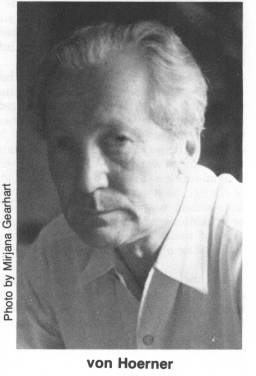 COSMIC SEARCH: It is almost two decades now without any positive results. Does that mean that SETI is a failure?
COSMIC SEARCH: It is almost two decades now without any positive results. Does that mean that SETI is a failure?
von Hoerner: No, I would certainly say not. Twenty years is a short time. Twenty years may seem long, but in astronomical terms and even in the development of science, 20 years is a very short time. So to have no positive result in 20 years is not a failure.
COSMIC SEARCH: Do you consider SETI to be a legitimate scientific pursuit?
von Hoerner: Yes, of course. It is an observational search for something which is theoretically possible. For example, neutron stars were considered theoretically possible a long time ago by Oppenheimer, and we think that in the form of pulsars we have detected them. Quarks (elementary sub-particles) are theoretically possible. We are searching for them which is very difficult and we haven't found any yet, but still the search continues with success as a real possibility. We are searching for gravitational waves because they are a possibility, but we have not found any yet. The neutrino radiation from the sun is a possibility. We are searching for it but haven't found the predicted amount. So, you see, there are many things which are theoretically possible. We search for them and in some cases we find something and in other cases we have not found them yet. Other intelligent beings are certainly a possibility, so why not search for them?
COSMIC SEARCH: You have often written that the sun is an average star, the earth an average planet, and that mankind has an average intelligence.
"If there is a galactic culture, a galactic club, then why not join it? We would lose our present culture, or what we think is a culture, and merge into a larger way of life."
von Hoerner: Yes, let us discuss the assumption of being average. The sun being an average star is a statement which we can make with confidence because we know a lot about the stars. But that the earth is an average planet is theoretical and we will have to see if we are right. We have not yet seen any other planets (outside our solar system).
COSMIC SEARCH: Serkowski is doing work on this now at the University of Arizona, isn't he?
von Hoerner: Yes, there are efforts going on but I would say that they are just at, or beyond, our present limits of observation. So far we have not seen planets of other stars. Still, from all our theoretical ideas about the formation of stars, we are almost sure that planets are the rule, so there ought to be lots of them.
Now one step further, regarding the
question of life on those planets and the question of intelligence. We have only one single case and that is us. And the question is, can we do statistics when the sample number N equals one? The answer is "yes", if you know the rules.
If you have only one example to go by, with N equals one, then you do have an estimator for the average, and that is the one case you have. This would mean we should assume that we are average. On the other side with N equal to one, we do not have an estimator for the mean error. In plain
English this means that the assumption that we are average has the highest probability of being right but we have not the slightest idea of how wrong it is.
COSMIC SEARCH: That's an interesting way of putting it.
von Hoerner: So much for statistics with N equal to one. We cannot make any solid statements about possibilities on other planets, but, still I would say that the assumption that our development is average has the best chance of being right. If we generalize our own case, our own past development and our present state of mind, we should expect a very large number of similar planets and similar civilizations with comparable kinds of intelligence with whom we could talk.
And why we haven't found any signals yet would just go back to your first question, namely, 20 years is a very short time. We haven't really made any dedicated effort, that is, we haven't spent any money for that purpose. We have used existing telescopes; we have used existing receivers, and only short periods of time. This may be the reason we haven't found any signals. What I have just said applies if we generalize our own present state of mind and situation. But, if we think about our own future and consider what we might be doing during the next 100 or 200 years and generalize that again, then the picture changes considerably.
COSMIC SEARCH: Could you please explain?
von Hoerner: Well, we are just beginning our space exploration — sending probes to other parts of our solar system. This activity is just getting started and will probably go on and continue to grow on an even larger scale. Plans for colonies on the Moon or colonies on Mars, underground or in shelters, have already been worked on. There is a lot we could do in terms of mining and of scientific exploration.
Just pure mining of materials is something we will have to consider. We are running out of supplies here on Earth and there are many resources on the Moon and Mars and mainly on the many asteroids. These are big chunks of minerals, and there are about 200,000 which are more than a kilometer in size or larger. Most probably in the next few generations, say in the next 100 years or so, we will engage in this kind of activity.
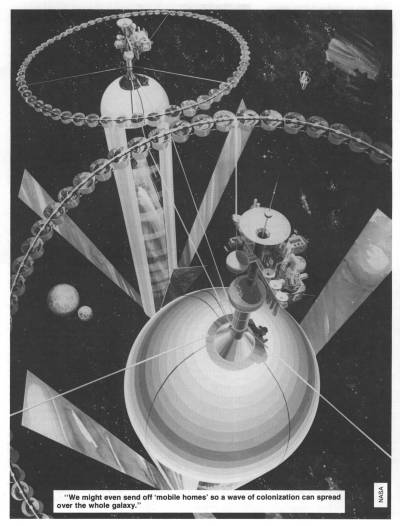 If we have colonies on the Moon and Mars with men and women living with their own children and grandchildren, the ties to the home planet will grow less and less important. After a while these colonies might send out people for trips lasting many generations, in 'mobile homes' so to say, to explore other solar systems. And if they find an inhabitable planet they will stay there and colonize it, and if not, they will go on searching.
If we have colonies on the Moon and Mars with men and women living with their own children and grandchildren, the ties to the home planet will grow less and less important. After a while these colonies might send out people for trips lasting many generations, in 'mobile homes' so to say, to explore other solar systems. And if they find an inhabitable planet they will stay there and colonize it, and if not, they will go on searching.
COSMIC SEARCH: What happens if mankind loses its exploratory instinct and becomes very complacent?
von Hoerner: Yes, that is a different possibility. Let's keep it in mind. I will come to it later.
I think that it is very probable that if we do not destroy ourselves, which has also a very high chance, that it is very probable that we will send out probes or expeditions to other planetary systems and we will look around in the galaxy. When we settle down on any of these other planets, the same things will be repeated. We will mine moons and other places. We might even send off 'mobile homes' again in other expeditions, so a wave of colonization can spread over the whole galaxy. Actually space travel becomes completely feasible even with our present technology, provided you forget the prejudice that it must be finished in one man's lifetime. Then we can cross the whole galaxy.
COSMIC SEARCH: So that in essence you are generating space colonization?
von Hoerner: Yes, an expanding wave of colonization just like the Polynesians and their tiny little fragile boats that colonized the Pacific ocean one island after another. It took many generations. That will be possible for us in the next generations, and we can do it. Generalizing our own case, we should remember that the sun is not an old star. It has only half the age of most other stars so whatever we think is possible for us should have been done long ago by the others. The number of stars with habitable planets has been estimated to be about one-half a percent of all stars, which means our whole galaxy would have about a billion habitable planets. This wave of colonization should have been started by any one out of one billion possible places about 4 billion years ago. The galaxy should be teeming with life and our own earth should have been colonized long ago by others, which is certainly not the case. The absence of extra-terrestrials in our own solar system would lead to the conclusion that there are no intelligent beings anywhere else, that we are the only ones.
COSMIC SEARCH: What happens if a civilization had encountered the earth, perhaps a long time ago and had a survey team, some kind of a patrol that came by, and said that the earth was not inhabitable for some reason? Wouldn't this be a possibility?
von Hoerner: Yes, this could have been the case at an early time, when, for example, we didn't have oxygen. If they were oxygen breathing beings like ourselves and they came by here and found no oxygen they could have said, "Let's go somewhere else, or try later on" or they could have planted something which would make the development they want.
COSMIC SEARCH: But perhaps by a natural selection effect that could have been the wrong way for something to develop. Perhaps the seed, or whatever they left, wasn't fit to survive on this planet.
von Hoerner: Yes, but again, the numbers are so big it could have been started in any one of a billion ways and a lot of different travelers could have been here and all of them must have found the earth unpleasant.
COSMIC SEARCH: This might be an explanation why we were overlooked by some civilizations.
von Hoerner: All these things are possibilities. Four billion years is a
long time and the one billion places where it could have started is a large number. There are other possibilities — our present state of mind, of technology and science and wanting to communicate. It may be that all civilizations which stay too long in this state destroy themselves, or, they survive this state only if they become very stagnant. It could be that either we blow ourselves up or we get stagnant and that there might not be much in between. It is the in-between cases that we look for.
"(The value of) one-way communication should never be underestimated."
COSMIC SEARCH: As you have written, it is a very narrow path we have to follow.
von Hoerner: Yes, there needs to be enough zest and drive left to start a big project, and enough stability and support to keep it going for a long time.
COSMIC SEARCH: Will man's natural curiosity sustain a search that may last centuries or even millennia?
von Hoerner: Yes, that is what I mean. With curiosity and drive and energy — push — you can do all these things. But, on the other hand, we can also destroy our civilization. If you want to avoid this crisis and institute a lot of regimentation and rules, and weed out everything which is dangerous, you also will weed out this kind of natural curiosity because it would be dangerous. I don't know the answer. The problem is the large number. It might be the case that civilizations just have to get stagnant in order to survive. But I cannot see that it must be so without an exception or two in a billion of cases.
COSMIC SEARCH: We haven't experienced a technological growth for a long enough time to know that in a 100, or 1000 years, we might not become stagnant. Now another question. There are those who say that contact with an extra-terrestrial civilization would benefit mankind and help to solve all the problems that we are laboring to solve on the earth now, for example, war, over-population, pollution, etc. Do you see such a contact as beneficial or otherwise?
von Hoerner: I would certainly think that it would be beneficial. Those who would come in contact with us are those who have survived so they must have solved the problems we are facing. I think the problems we on Earth are facing are quite common. Whoever is around (of these older civilizations) would have had the same problems and perhaps could give us good advice.
COSMIC SEARCH: What if they were malevolent?
von Hoerner: I don't think they would be. Those that are badly aggressive would have killed each other or blown up their own planets. Those who survive would be more gentle, peaceful, and reasonable.
COSMIC SEARCH: They would also have learned how to survive in a small living space too. That becomes important.
von Hoerner: There is a lot to be learned from those who have survived.
COSMIC SEARCH: Do you see that there might one day be a multinational effort in searching for extraterrestrial intelligence? Would that be better than nations looking individually?
von Hoerner: A multi-national effort might well end SETI. For example, we would never have had a man on the moon if there had not been a cold war. We needed the competition. We want to demonstrate our powers, our abilities. That is one of the big driving forces, at least for those who dispense the money. It is not the driving force for the scientist, but it is for the politician. I think if we make this a completely international effort we will end up with a lot of committees and nothing will ever get done.
COSMIC SEARCH: Perhaps this is a reason to keep politics out of SETI?
von Hoerner: Oh, we should have international conferences and we should try to learn from each other. That is a different thing. But we should not try to organize it money-wise and politically on a common base.
COSMIC SEARCH: Would you
speculate on the impact of a successful SETI search?
von Hoerner: It would be much larger than any of us can imagine at the moment. I would say it would be the end of our culture. Like any Stone Age culture coming into contact with us loses its culture.
The same would happen to us. We only hope that the others would handle
it somewhat better than we did for our own natives.
COSMIC SEARCH: Maybe that's why there has been no contact. "They" are doing a good job of this.
von Hoerner: Coming into contact with a more highly developed culture always means the end of your own. I would say that is a certainty. But whether it is good or bad is a matter of opinion. I would like to see our culture merge with the other one. If there is a galactic culture, a galactic club, then why not join it? We would lose our own present culture, or what we think is a culture, and merge into a larger way of life. This is the only way it should go.
COSMIC SEARCH: And that would assure our continued existence?
von Hoerner: Yes, probably so.
COSMIC SEARCH: If you were organizing a new SETI search with today's state of technology and knowledge of the universe, where would you look? What criteria would you use?
von Hoerner: I would say it could be done in three different ways. Number one is that you do not make any special search. Many astronomers do normal astronomy and just keep their eyes open for anything unusual which might point to a possibility of other beings. For example, the first pulsar was very suspicious. Unfortunately, it found a natural explanation. What we do is look for unusual things which lead to something other than a natural explanation.
Number two is done occasionally by a small number of astronomers. They think up some special search programs which can be done with existing equipment, using existing telescopes, using existing receivers — maybe special correlators or something — but not investing much money or much time either.
COSMIC SEARCH: What mode of communication might be expected?
von Hoerner: We do not know which mode of communication they might use but we should explore those methods which we know are possible. Radio contact is certainly one, there is no question, so we should search for radio signals. Freeman Dyson ("Science" June 3, 1960) has ideas about how a further developed civilization uses all the radiation of a star by building a sphere around it. This sphere will emit in the infra-red so we should look for infra-red sources. We have found a few but so far they have natural explanations. We should
make many different, special planned searches for signals or other signs of life with existing equipment. That's method two.
Now, method number three would involve investing larger sums of money and making dedicated searches with dedicated instruments built especially for that purpose, Again we cannot be sure that we have the best method. There might be much better ways of communication but we should remember that this negative argument will never change. Suppose we say now, let's wait a thousand years. It is likely that in a thousand years we'll know better methods than are known today. But after 1000 years we might say again, let's wait another thousand years for still better methods. The point is we can never be sure we have the best method; it is just not possible. So we might as well start right now after having found one possible method, namely radio contact on a likely frequency.
COSMIC SEARCH: You mean do it now instead of waiting a few hundred years when our priorities might be different?
von Hoerner: Yes, that is a very good point. And we should try several methods. We could build larger telescopes for radio and for infra-red, or optical lasers have also been suggested; so we shouldn't get stuck with just one single method. We should investigate several and we should not hesitate to invest some of our money in them.
COSMIC SEARCH: Let's assume that we have established contact with an extra-terrestrial intelligence. Is the communication a one-way street or is it a two-way street?
von Hoerner: Two way communication we might describe as communication where questions are asked and answers are given. In order that waiting times wouldn't be too long between questions, means that the distances cannot be too great. However, if the distance is as much as 500 light years, for example, the answer to any question will take 1000 years. And the question then is: Will we still be interested in the answer to a question we have asked a thousand years ago? I would say that we probably wouldn't be interested.
In this case, it would be a one-way communication where we get a wealth of information without asking for it, but we should never underestimate its
value. For example, our whole western civilization has been greatly influenced by the ancient Greeks and their culture although they left nothing for us but a few books and some art. It was a one-way communication. All our cultural inheritance, all our traditions, and we live a great deal by traditions, all this has been a one-way communication from the people of many generations ago to us. One-way communication should never be underestimated.
COSMIC SEARCH: How will the communication be carried out? What kind of language will be used, etc.?
von Hoerner: I think we will be taught. We are the beginners. The others are far ahead so they will talk to us and we will need to learn to understand them and their methods just as children learn from adults.
COSMIC SEARCH: Are you assuming that an extra-terrestrial intelligence has the patience to teach us, and that we are willing to be students?
"Trying to establish contact with other beings in the universe is our next great task. Success would mean the largest step in the evolution of mankind since the development of speech about a million years ago."
von Hoerner: Well, if they have enough interest they will have the patience, and if, again, we assume that we have a strong desire to communicate, it certainly can be done. Even if they are very far advanced they might still know how to talk to children. We learn what they consider to be baby talk and later we will grow up and acquire a fuller understanding.
COSMIC SEARCH: Can you see an extra-terrestrial civilization as picking out certain people within a given range as candidates or students? How would it be done?
von Hoerner: In any interstellar communication, because of the long waiting time involved, it will not be communication between individuals. It will be communication between civilizations. Planet Earth will talk to some other planet somewhere far off.
COSMIC SEARCH: Would an
Arecibo-type message of the kind sent out a few years ago to a star cluster, some 20,000 light years distant in the constellation Hercules, be a valid way for us to contact another civilization, or do you think that it was a futile attempt?
von Hoerner: We are sending out messages all the time by radio and television whether we like it or not. These are strong signals and they are going out all the time so we are announcing our presence all around us. This is the first point. Second, there are very few instances where we have purposely tried to send a message. The first is what you called the Arecibo message. This was by radio signals for a very short time and in only one direction. The second message involved a metallic plaque with a picture (man, woman, solar system, pulsars, etc.) aboard Pioneer X, which will pass Pluto's orbit and leave the solar system. The third is the Voyager message. This consists of two metal discs like our records with all the equipment and instructions to play them. The discs have pictures of the earth and sounds of the earth and selections of all our kinds of music. Now these things are messages from us to other civilizations, but their chance ever of being received is very remote.
COSMIC SEARCH: Then in fact they are a practice exercise?
von Hoerner: They are that, but they are more than that. They are a message to ourselves. They try to make us think about ourselves as seen through the eyes of others and that is very valuable. If you try to say to someone else what you are, you first have to think about what you are. That is very valuable, regardless of whether anyone else listens or not.
COSMIC SEARCH: The messages, then, are a message of the Earth's civilization from a unified standpoint?
von Hoerner: Yes, the messages are about us; we on Earth talk about us, about our intelligence. When we send messages, they make us think about ourselves from a distant point of view which might give us a much better perspective about our own problems. I would say this is very valuable even if nobody else gets the message.
COSMIC SEARCH: Is the recent upsurge in the pseudo-sciences an indication that man is thinking that he has some small part in a huge cosmic connection? Are we interested and receptive to SETI because of that?
von Hoerner: By pseudo-science do you mean things like UFOS?
COSMIC SEARCH: Yes, and astrology.
von Hoerner: That is a very good question and I think there may be some connection. We would like to think that life makes sense, and strong religious belief can give us support and explanations. Astrology can do this for some persons. Many religions talk about higher developed beings sometimes thought to be hovering around trying to help us — we don't call them angels any more but UFOs fit in this category. There may be a certain connection between this belief in higher beings and our strictly scientific search for extra-terrestrial intelligence.
COSMIC SEARCH: Finally, where
does SETI fit in a historical perspective?
von Hoerner: I seriously think that trying to establish contact with other beings in the universe is our next great task and that success would mean the largest step in the evolution of mankind since our development of speech about a million years ago. Meanwhile as a fringe benefit thinking about life in space may be helpful in giving us a better perspective for looking at our own affairs and problems.
 Sebastian von Hoerner was born in Görlitz, Germany, in 1919. He received his Ph.D. degree in physics from the University of Göttingen in 1951. Dr. von Hoerner was associated with the Max Planck Institute for Physics (Göttingen) and the Astronomical Computation Institute (Heidelberg) before joining the National Radio Astronomy Observatory (Greenbank, West Virginia) as staff scientist in 1962. He has worked on problems of stellar dynamics, star formation, shock front propagation, lunar occulations, cosmology, gravitational collapse, life in space and the structural analysis and optimization of radio telescopes, pioneering the homologous antenna concept. Von Hoerner is the author of three astronomy books and over 65 articles in scientific journals. He has been a visiting professor and lecturer at Cornell, UCLA (Los Angeles), Bonn, Mexico City and Basel (Switzerland), and currently is a member of the Editorial Board of COSMIC SEARCH.
Sebastian von Hoerner was born in Görlitz, Germany, in 1919. He received his Ph.D. degree in physics from the University of Göttingen in 1951. Dr. von Hoerner was associated with the Max Planck Institute for Physics (Göttingen) and the Astronomical Computation Institute (Heidelberg) before joining the National Radio Astronomy Observatory (Greenbank, West Virginia) as staff scientist in 1962. He has worked on problems of stellar dynamics, star formation, shock front propagation, lunar occulations, cosmology, gravitational collapse, life in space and the structural analysis and optimization of radio telescopes, pioneering the homologous antenna concept. Von Hoerner is the author of three astronomy books and over 65 articles in scientific journals. He has been a visiting professor and lecturer at Cornell, UCLA (Los Angeles), Bonn, Mexico City and Basel (Switzerland), and currently is a member of the Editorial Board of COSMIC SEARCH.
|
Off the Shelf
By: Mirjana Gearhart
[Article in magazine started on page 46]
The literature of SETI is extensive. In this and future issues of COSMIC SEARCH selected books and other publications are listed with pertinent information. Space prevents the inclusion of more than a small number in each issue. We believe you will find in these references much that will add to your knowledge and understanding while imparting something of the adventure and excitement of SETI.
P. Anderson, IS THERE LIFE ON OTHER WORLDS?, 1963, Crowell-Collier Press, New York, N.Y. (216 pg., hardbound). Includes not only what scientists believe to be fact, but careful speculation by famous scientists.

Isaac Asimov, THE WELLSPRINGS OF LIFE, 1960, Abelard-Schuman, New York, N.Y. (233 pg., hardbound). Discusses the possibility of billions of earth-type planets perhaps suited for life.

Kees Boeke, COSMIC VIEW, 1957, John C. Day Co., New York, N.Y. (48 pg., hardbound). The universe in 40 jumps — from the nucleus of an atom to the edge of our known universe.

Ronald N. Bracewell, THE GALACTIC CLUB: INTELLIGENT LIFE IN OUTER SPACE, 1975. W. H. Freeman and Co., San Francisco. (142 pg., paperbound). Man's preparations for a SETI encounter, space probes, and space colonization.

A.G.W. Cameron, INTERSTELLAR COMMUNICATION, 1963, W. A. Benjamin, Inc., New York, N.Y. (317 pg., hardbound). An extensive collection of reprints and original contributions.

James L. Christian, ed., EXTRATERRESTRIAL INTELLIGENCE: THE FIRST ENCOUNTER, 1976, Prometheus Books, Buffalo, N.Y. (302 pg., paperbound). Some famous writers discuss a number of philosophical questions raised by SETI.

Frank D. Drake, INTELLIGENT LIFE IN SPACE, 1967, The Macmillan Co., New York, N.Y. (128 pg., hardbound). Explores the whole history of extraterrestrial communication and how it has evolved.

J. S. Hey, THE RADIO UNIVERSE, 2nd ed., 1975. Pergamon Press, New York, N.Y. (264 pg., paperbound). An introduction to all aspects of radio astronomy.

A. A. Imshenetsky, EXTRATERRESTRIAL LIFE AND ITS DETECTION METHODS, 1970, NASA Technical Translation #TTF-710 (252 pg., paperbound). A collection of theoretical and experimental articles on various problems of space biology. Translated from the Russian.

John Kraus, BIG EAR, 1976, Cygnus-Quasar Books, Powell, Ohio (228 pg., paperbound and hardbound). A short, personal history of radio astronomy and an introduction to SETI.

Roger A. MacGowan and Frederick I. Ordway, III, INTELLIGENCE IN THE UNIVERSE, 1966, Prentice Hall, Inc., Englewood, N.J. (377 pg., hardbound). Reviews the possibilities of communicating with life beyond the Solar System and views its potential characteristics, capabilities, and social implications.

Gregg Mamikunian and Michael H. Briggs, Eds., CURRENT ASPECTS OF EXOBIOLOGY, 1965, Pergamon Press, Inc., Oxford, England. (558 pg., hardbound). Presents the early stages in the scientific study of exobiology and life on worlds other than our own.

Philip Morrison, John Billingham and John Wolfe, eds., THE SEARCH FOR EXTRATERRESTRIAL INTELLIGENCE (SETI), 1977, NASA/AMES Research Center, NASA, Moffett Fld. CA SP-419. (276 pg., paperbound). Reports findings of a series of NASA workshops dealing with both the existence and detection of extraterrestrial intelligence.

Bernard Oliver and John Billingham, eds., CYCLOPS: PROJECT CYCLOPS, A DESIGN STUDY OF A SYSTEM FOR DETECTING EXTRATERRESTRIAL LIFE, 1973, NASA/AMES Research Center, Moffett Field, CA. #CR111445. Write to John Billingham for copies. (243 pg., paperbound). Extensive study of the Project Cyclops team, meeting at NASA/AMES Research Center, summer 1971.

A. I. Oparin, LIFE, ITS NATURE, ORIGIN AND DEVELOPMENT, 1961, Academic Press, New York, N.Y. (207 pg., hardbound). A review of the nature of life and mechanisms which contribute to the origin of life. This author predicts life forms elsewhere and speculates on their complexity.

Cyril Ponnamperuma and A.G.W. Cameron, INTERSTELLAR COMMUNICATION: SCIENTIFIC PERSPECTIVES, 1974. Houghton-Mifflin Co., Boston, Mass., (186 pg., hardbound). Collection of essays on interstellar communication presented in a lecture series at NASA/AMES Research Center, 1971.

Ian Ridpath, MESSAGES FROM THE STARS, 1978, Harper and Row, Publishers, Inc., New York, N.Y. (256 pg., paperbound). By first examining attempts to find life in space, and then colonization of space, the author tells the story of the search for life in space.

Ian Ridpath, WORLDS BEYOND: A REPORT ON THE SEARCH FOR LIFE IN SPACE, 1975, Harper & Row Publishers, Inc., New York, N.Y. (172 pg., paperbound). A comprehensive, well-illustrated report on the possibilities of extraterrestrial intelligence.

Carl Sagan, COSMIC CONNECTION, 1973, Anchor Press, Garden City, N.Y. (274 pg., paperbound). An extraterrestrial perspective.

Carl Sagan, ed. COMMUNICATION WITH EXTRATERRESTRIAL INTELLIGENCE (CETI), 1973, M. I. T. Press, Cambridge, Mass. (410 pg., hardbound). A detailed account of the first international meeting on communication with extraterrestrial intelligence held in Armenia in 1971.

I. S. Shklovskii, and Carl Sagan, eds., INTELLIGENT LIFE IN THE UNIVERSE, 1966, Holden-Day, San Francisco, (488 pg., hardbound). The first substantive book on all aspects of interstellar communication. A collective venture by two distinguished authors, one American and one Soviet.

Marcia Smith, EXTRATERRESTRIAL INTELLIGENCE AND UNIDENTIFIED FLYING OBJECTS: A SELECTED, ANNOTATED BIBLIOGRAPHY, 1976, Library of Congress, Congressional Research Service, Washington D.C. Feb. 18, 1976, No. 75-35SP. (45 pg. paperbound). An annotated bibliography.

Walter Sullivan, WE ARE NOT ALONE: THE SEARCH FOR INTELLIGENT LIFE ON OTHER WORLDS, 1964, Revised ed., 1966, McGraw-Hill, Hightstown, N.J. (326 pg., hardbound). An excellent, detailed history and discussion of SETI from many viewpoints.

U.S. Government Printing Office, POSSIBILITY OF INTELLIGENT LIFE ELSEWHERE IN THE UNIVERSE, 1977, prepared by Marcia S. Smith, Washington, D.C. (126 pg., softbound). A comprehensive document on SETI prepared for members of the U.S. Congress.

Gerritt L. Verschuur, COSMIC CATASTROPHIES, 1978, Addison-Wesley Publishing Co., Reading, Mass. (208 pg., softbound). How cosmic events on the largest scale can affect our lives and destroy the entire planet.
|
|
Miscellaneous Items
Information About the Publication
(Editorial Board, Editors, Table of Contents)

ISSN 0161-8555
CODEN: COSEDN
Editorial Board
- Richard Berendzen, University Provost, The American University
- John Billingham, Director SETI Program, NASA-AMES Research Center
- Ronald Bracewell, Director, Radio Astronomy Observatory, Stanford University
- Thomas A. Clark, NASA-Goddard Space Flight Center
- Arthur C. Clarke, Sri Lanka, author of °2001, A Space Odyssey"
- Norman Cousins, Chairman, Editorial Board, SATURDAY REVIEW
- Frank D. Drake, Director, National Astronomy and Ionosphere Center (Arecibo), Cornell University
- Robert E. Edelson, SETI Project Manager, Jet Propulsion Laboratory California Institue of Technology
- Donald S. Hall, Director, Strasenburgh Planetarium, Rochester, New York; President, International Planetarium Society
- Theodore M. Hesburgh, President, University of Notre Dame
- Nikolai Kardashev, Space Research Institute, Academy of Sciences, Moscow, USSR
- Philip Morrison, Physics Department, Massachusetts Institute of Technology
- Bernard Oliver, Vice President, Hewlett-Packard Company; Director of NASA-Ames Cyclops Project
- Cyril Ponnamperuma, Director, Laboratory of Chemical Evolution, University of Maryland
- Martin Rees, Director, Institute of Astronomy, Cambridge University, England
- Carl Sagan, Director, Laboratory for Planetary Studies, Cornell University
- Walter Sullivan, Science Editor, New York Times
- V. S. Troitsky, Radiophysical Scientific Research Institute, Gorky, USSR
- Sebastian von Hoerner, National Radio Astronomy Observatory
Editors, and Others Involved in the Publication
Editors: Robert S. Dixon and John Kraus, Ohio State University Radio Observatory
Managing Editor: Mirjana Gearhart, Ohio State University Radio Observatory
Subscription Manager: Lesly Arnold
Assistants: Richard Arnold, Gregory Brown, Pene Curmode, Jerry R. Ehman, Wendy McKenna, David Raub, Hazel Snyder, Janet Stevens
The Cover
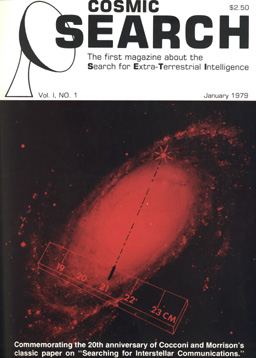
The Cover: Impression of a beacon signal from a galactic source detected with a receiver tuned to a 21 CM (centimeter) wavelength.
Text at the Bottom of the Cover: Commemorating the 20th anniversary of Cocconi and Morrison's classic paper on "Searching for Interstellar Communications."
About COSMIC SEARCH
COSMIC SEARCH is published 6 times a year by Cosmic-Quest, Inc. Copyright © 1978 by Cosmic-Quest, Inc. All rights reserved.
Cosmic Quest, Inc., is a private non-profit organization dedicated to the promotion and support of SETI endeavors.
Subscription price: $12 a year in U.S. (and possessions), $16 elsewhere. Single copies: $2.50 in U.S. (and possessions), $3 elsewhere.
Address subscriptions and all other correspondence to: Radio Observatory, Box 293, Delaware, Ohio 43015.
Application to mail at second-class postage rates is pending at Delaware, Ohio, and at additional mailing offices.
Table of Contents (in magazine)
| Item | Pg |
|---|
| Editorials | 2, 3 |
| Searching for Interstellar Communication by Giuseppi Cocconi and Philip Morrison | 4 |
| Twenty Years After. . . by Philip Morrison | 7 |
| A Reminiscence of Project Ozma by Frank D. Drake | 10 |
| Little Green Men, White Dwarfs or Pulsars? by S. Jocelyn Bell Burnell | 16 |
| Trouble in Aquila by Arthur C. Clarke | 22 |
| Rendezvous with Infinity by Norman Cousins | 30 |
| Time and a Cosmic Perspective by Richard Berendzen | 36 |
| What If We Succeed? by Walter Sullivan | 37 |
| Features | |
| SETI Forum: Exclusive COSMIC SEARCH interview with Sebastian von Hoerner | 40 |
| Next Issues | 21 |
| The SEnTlnel (SETI News) | 25 |
| ABCs of SETI | 32 |
| SEARCH Awards | 39 |
| Glossary | 45 |
| Off The Shelf | 46 |
Purpose of COSMIC SEARCH
The purpose of COSMIC SEARCH is to present all aspects of the search for intelligent life in space in a popular but responsible manner.
Coming in COSMIC SEARCH
- "The Quest for Extraterrestrial Intelligence" by Carl Sagan
- "Extraterrestrial Politics" by Michael Michaud
- "Generalized Life" by Jerome Rothstein
- "Man's Role in the Galaxy" by Ronald Bracewell
- "Extraterrestrial Life: Where is Everybody?" by Jesco von Puttkamer
- "Interstellar Communication with Gravity Waves" by David Douglass
- "Cosmic Languages" by Hans Freudenthal
and many more
- FORUM: Exclusive interview on "Space Colonization and SETI" with Gerard K. O'Neill
- ABCs of SETI will explain in simple terms:
The Solar Neighborhood (the "nearby" stars)
The Galactic Neighborhood (the "nearby" galaxies)
The Second Waterhole (where is it?)
The Unique or Average Question (which are we?)
Broadband and narrowband signals (you hear them all the time)
- More SEnTlnel news reports, "Off the Shelf" books and other special features.
Glossary
- Astronomical Unit:
- A unit of length equal to the distance of the earth from the sun, about 150 million kilometers.
- Bandwidth:
- The wavelength or frequency range to which a receiver responds. Bandwidths can be described as narrow or wide, according to their range.
- Big Bang:
- The beginning event in the Universe. The explosion of this primordial fireball some 15 billion years ago caused the initial outward expansion of gas and dust which formed the universe. CETI: An acronym for Communication with Extra-Terrestrial Intelligence.
- Civilization:
- According to the Russian astrophysicist Kardashev, civilizations can be classified according to their energy outputs as follows:
- Type I:
- A civilization capable of using all of the energy falling on its planet from its "sun" for interstellar communication. (For us this would be equal to 10,000 times the present total energy consumption by mankind for all purposes.) Hence, we are more like a "Type O" civilization.
- Type II:
- A civilization capable of using the total energy output of its "sun" for interstellar communication.
- Type III:
- A civilization capable of using the total energy output of our galaxy for interstellar communication.
- Dipole:
- A configuration with a plus and minus charge. An antenna one-half wavelength long.
- Doppler Shift:
- The resulting frequency change caused by the relative motion along a line of sight between two observers.
- Exobiology:
- The study of extraterrestrial life forms.
- Fourier Analysis:
- The decomposition of a signal into its simplest harmonic curves (sines and cosines).
- Galaxy:
- A large system of stars. Our galaxy, the Milky Way, is a spiral galaxy containing some 100,000 million stars, 100,000 light years in diameter and 10,000 light years thick.
- Gigahertz:
- A unit of frequency equal to 1,000 million hertz.
- Hertz:
- A unit of frequency equal to one cycle per second.
- Hydrogen:
- The most abundant element in the universe. It radiates naturally at a wavelength of 21 centimeters.
- Light Year:
- The distance traveled by light in one year, about 10 trillion kilometers.
- Light (speed of):
- In empty space: 300,000 kilometers per second.
- Maser:
- A sensitive amplifying device employing energy jumps of atomic particles.
- Megahertz:
- A unit of frequency equal to one million hertz.
- Parametric amplifier:
- A sensitive amplifying device which employs the properties of non-linear elements.
- Redshift:
- A shift toward the longer wavelengths of the optical spectrum due to recessional velocity (the Doppler effect).
- SETI:
- An acronym for Search for Extra-Terrestrial Intelligence.
- Zeeman effect:
- A broadening or splitting of radiation from a substance into several wavelengths because of the presence of a magnetic field.
SEARCH AWARDS
For best papers on SETI
Category 1. Undergraduate students
Category 2. Graduate students
Category 3. Anyone else under 30 years of age
Papers may be on any aspect of the Search for Extra-Terrestrial Intelligence (SETI). Papers must be double-spaced typewritten with one inch margins on 8 1/2 by 11 inch bond paper and less than 2000 words in length. Any illustrations must be clearly executed.
Authors of best papers will be given a SEARCH AWARD of $100 and the paper will be published in COSMIC SEARCH. Authors should include their full address and telephone number. Authors should enclose a self-addressed stamped envelope if they wish to have their manuscripts returned. Manuscripts accepted and published are copyrighted and become the property of COSMIC SEARCH magazine.
Manuscripts may be submitted at any time. Their review is a continuous, on-going process. Each article received is reviewed by a special committee and if judged worthy, either in its original form or after revisions, will be given a SEARCH AWARD. The opinion of the committee is final.
A contestant may submit and have under review only one manuscript at a time and be eligible for only one SEARCH AWARD in one category. However, it is possible for one person to achieve SEARCH AWARDS sequentially in each of the three categories.
Address SEARCH AWARD Committee, Radio Observatory, P.O. Box 293, Delaware, Ohio 43015.
SEARCH PUZZLE
[Click on image below to obtain a larger version. In your browser you may need to uncheck the preference that says something like "Resize large images to fit in window" to avoid seeing a scaled image that appears smaller than the image below.]
Miscellaneous Quotes
The following quotes are not directly associated with any article. They are listed here in the order in which they appear in the magazine; page numbers are given. Uncredited quotes should be credited to the Editors of COSMIC SEARCH magazine.
Quote on page 6
"Observe how system into system runs;
What other planets circle other suns;
What varied beings people every star."
Alexander Pope (1688-1744)
Quotes on page 24
"Does it make sense to work at guaranteeing supplies of energy for our population in the year 2025 while ignoring the finite probability that a nuclear (war) could annihilate this same population before that date?"
Harold L. Davis, Editor of "Physics Today," endorsing statement by Victor Weisskopf that abolition of the nuclear arms race "is the first and foremost problem of our time."
"The earth is our cradle,
The solar system our kindergarten,
The galaxy our middle-school and
The universe our university."
Sedgewick Seti
"99.9 percent of the species that have ever lived on the earth are now extinct."
Richard Lewontin in "Scientific American."
"Mankind are very odd creatures."
Benjamin Franklin
Quote on page 31
"It is reasonable to believe that
- the search for extra-terrestrial intelligence will contribute significantly to the solving of our problems here on earth."
- these signals from the cosmos could contribute vastly more to our future security than instruments of mass annihilation."
- the future of the human race may depend upon keeping the rendezvous with infinity."
Miscellaneous Photos
The following photos are not directly associated with any article. They are shown on this webpage at a relatively small size in the order in which they appear in the magazine. Click on each photo to obtain a larger size version.
Photo on Inside Front Cover
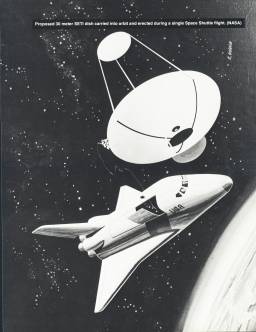
Photo on Page 48
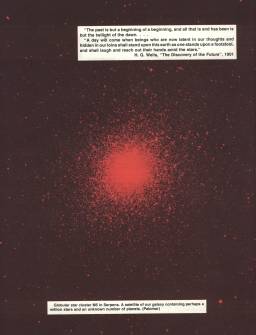
Photo on Outside Back Cover
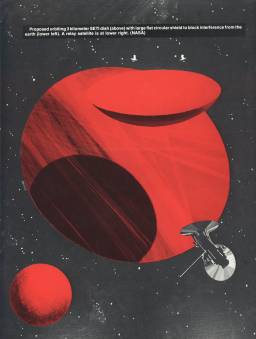
Miscellaneous Graphics
The following graphics are not directly associated with any article. They are listed here in the order in which they appear in the magazine.
|
![[NAAPO Logo]](../../Images/NAAPOsm.jpg)

 Giuseppe Cocconi is research physicist at the Centré Européen Recherche Nucléaire (CERN) in Geneva, Switzerland where he has been for the past 16 years. Born in Como, Italy, in 1914, receiving his doctor's degree from the University of Milan in 1937, teaching physics there and at the University of Catania (Italy), he became professor of physics at Cornell University in 1947 where he stayed until going with CERN in 1963. His interests include atomic particle interactions, cosmic rays and radio astronomy.
Giuseppe Cocconi is research physicist at the Centré Européen Recherche Nucléaire (CERN) in Geneva, Switzerland where he has been for the past 16 years. Born in Como, Italy, in 1914, receiving his doctor's degree from the University of Milan in 1937, teaching physics there and at the University of Catania (Italy), he became professor of physics at Cornell University in 1947 where he stayed until going with CERN in 1963. His interests include atomic particle interactions, cosmic rays and radio astronomy.
 Philip Morrison has been professor of
physics at the Massachusetts Institute of Technology since 1965. Born in
Somerville, New Jersey, in 1915 he earned his Ph.D. degree at the University
of California in 1940 and then taught physics at San Francisco State College
and the University of Illinois. Following two years as group leader at the
Los Alamos Scientific Laboratory he was on the physics faculty of Cornell
University from 1946 to 1965. Dr. Morrison has won a number of prizes for
his work including the Pregel prize (1955), Babson prize (1957), and the
Oersted Medal (1965). His interests are in the application of physics to
astronomy. Author of numerous articles, many on SETI, participator in many
SETI conferences and workshops, he recently was chairman of a NASA SETI
advisory committee. He is a member of the Editorial Board of COSMIC SEARCH
and for many years he has been book editor of "Scientific American".
Philip Morrison has been professor of
physics at the Massachusetts Institute of Technology since 1965. Born in
Somerville, New Jersey, in 1915 he earned his Ph.D. degree at the University
of California in 1940 and then taught physics at San Francisco State College
and the University of Illinois. Following two years as group leader at the
Los Alamos Scientific Laboratory he was on the physics faculty of Cornell
University from 1946 to 1965. Dr. Morrison has won a number of prizes for
his work including the Pregel prize (1955), Babson prize (1957), and the
Oersted Medal (1965). His interests are in the application of physics to
astronomy. Author of numerous articles, many on SETI, participator in many
SETI conferences and workshops, he recently was chairman of a NASA SETI
advisory committee. He is a member of the Editorial Board of COSMIC SEARCH
and for many years he has been book editor of "Scientific American".





 It had only one signal channel, and the simplest of outputs — a chart recorder. We also planned to have an ordinary audio tape recorder connected to the system just in case something did come in from outer space! There were some other important special aspects of the receiver. It switched between two feed horns so as to allow us to distinguish a signal from space from a terrestrial signal coming in the side-lobes of the antennas. The same approach has been used in some form in just about all the searches since. Also, there was a reference channel to which the signal channel was compared; this was a standard technique in those days and now, and was used to eliminate receiver gain fluctuations and nonlinearities. Since our bandpass was to be 100 hertz, the oscillators used in the receiver had to be a bit more stable than usual, although nothing very challenging. After a while Kochu Menon, an old friend and colleague from Harvard, came to Green Bank and worked on the receiver also.
It had only one signal channel, and the simplest of outputs — a chart recorder. We also planned to have an ordinary audio tape recorder connected to the system just in case something did come in from outer space! There were some other important special aspects of the receiver. It switched between two feed horns so as to allow us to distinguish a signal from space from a terrestrial signal coming in the side-lobes of the antennas. The same approach has been used in some form in just about all the searches since. Also, there was a reference channel to which the signal channel was compared; this was a standard technique in those days and now, and was used to eliminate receiver gain fluctuations and nonlinearities. Since our bandpass was to be 100 hertz, the oscillators used in the receiver had to be a bit more stable than usual, although nothing very challenging. After a while Kochu Menon, an old friend and colleague from Harvard, came to Green Bank and worked on the receiver also.
 The driver was Sam Harris, known to every radio ham as a radio amateur magazine editor, and known to many and soon to me as an electronics genius. He had designed the parametric amplifier, and was the only one in the world who could make it work, and it really worked. He proceeded to install it, make it do its magic, and then taught me how to tune it, the task which became my four-o'clock-in-the-morning pick-me-up for the day. When all was well, he climbed back in his Morgan and drove off. I never saw him again until one day in 1966, I met that red beard again; this time he was on the staff of my observatory at Arecibo (I had nothing to do with this improbable event), and he has been there ever since, doing his magic.
The driver was Sam Harris, known to every radio ham as a radio amateur magazine editor, and known to many and soon to me as an electronics genius. He had designed the parametric amplifier, and was the only one in the world who could make it work, and it really worked. He proceeded to install it, make it do its magic, and then taught me how to tune it, the task which became my four-o'clock-in-the-morning pick-me-up for the day. When all was well, he climbed back in his Morgan and drove off. I never saw him again until one day in 1966, I met that red beard again; this time he was on the staff of my observatory at Arecibo (I had nothing to do with this improbable event), and he has been there ever since, doing his magic.
 Frank D. Drake was born in Chicago in 1930. After service with the U.S. Navy and earning the Ph.D. degree in astronomy from Harvard University in 1958, he was scientist for 5 years at the National Radio Astronomy Observatory, Green Bank, West Virginia. It was during this period that he performed the historic "Ozma" experiment. In 1964 Drake joined the faculty of Cornell University where he is now [at the time the article was written] Goldwin Smith Professor of Astronomy and Director of the National Astronomy and Ionosphere Center, which includes the Arecibo Observatory. He is author of many papers and a number of books including "Intelligent Life in Space" (1967). In 1978 he received the American Tentative Society Award for his Project Ozma. Drake is a member of many scientific societies including the National Academy of Sciences. He is a member of the Editorial Boards of the Astrophysical Journal, Science Year and COSMIC SEARCH.
Frank D. Drake was born in Chicago in 1930. After service with the U.S. Navy and earning the Ph.D. degree in astronomy from Harvard University in 1958, he was scientist for 5 years at the National Radio Astronomy Observatory, Green Bank, West Virginia. It was during this period that he performed the historic "Ozma" experiment. In 1964 Drake joined the faculty of Cornell University where he is now [at the time the article was written] Goldwin Smith Professor of Astronomy and Director of the National Astronomy and Ionosphere Center, which includes the Arecibo Observatory. He is author of many papers and a number of books including "Intelligent Life in Space" (1967). In 1978 he received the American Tentative Society Award for his Project Ozma. Drake is a member of many scientific societies including the National Academy of Sciences. He is a member of the Editorial Boards of the Astrophysical Journal, Science Year and COSMIC SEARCH.


 S. Jocelyn Bell Burnell was born in northern Ireland in 1943. After receiving a B.S. degree in physics from Glasgow University, Scotland, she went to Cambridge University, England, where she earned her doctorate in radio astronomy in 1969. Since then she has done research in the newest branches of astronomy involving gamma-rays and x-rays. In 1978 she received the American Tentative Society Award for her pulsar research. Currently she is a research scientist at the Mullard Space Science Laboratory of the University College London.
S. Jocelyn Bell Burnell was born in northern Ireland in 1943. After receiving a B.S. degree in physics from Glasgow University, Scotland, she went to Cambridge University, England, where she earned her doctorate in radio astronomy in 1969. Since then she has done research in the newest branches of astronomy involving gamma-rays and x-rays. In 1978 she received the American Tentative Society Award for her pulsar research. Currently she is a research scientist at the Mullard Space Science Laboratory of the University College London.
 What's going on in this constellation? Why did 25 percent of the novae in a forty-year period appear in only 0.25 percent of the sky? Is the front line moving in our direction?
What's going on in this constellation? Why did 25 percent of the novae in a forty-year period appear in only 0.25 percent of the sky? Is the front line moving in our direction?
 2. On the same subject, possibly. The galaxy M87 has, jutting out from its heart, a luminous jet unique in the known universe. (See article by Otto Struve, 'Virgo A', in the February 1961 issue of Sky and Telescope.) This brilliant jet, according to the Russian astronomer I. S. Shklovsky, liberates as much energy as the explosion of
10,000,000 supernovae. To provide this amount of energy it would be necessary to annihilate the mass of a hundred suns.
2. On the same subject, possibly. The galaxy M87 has, jutting out from its heart, a luminous jet unique in the known universe. (See article by Otto Struve, 'Virgo A', in the February 1961 issue of Sky and Telescope.) This brilliant jet, according to the Russian astronomer I. S. Shklovsky, liberates as much energy as the explosion of
10,000,000 supernovae. To provide this amount of energy it would be necessary to annihilate the mass of a hundred suns.


 To appreciate the full significance of searching for extraterrestrial intelligence we must shift our thinking far beyond our solar system to other stars of our galaxy and even galaxies beyond our own. As a first step, in this issue, let's consider our own galaxy and how we relate to it.
To appreciate the full significance of searching for extraterrestrial intelligence we must shift our thinking far beyond our solar system to other stars of our galaxy and even galaxies beyond our own. As a first step, in this issue, let's consider our own galaxy and how we relate to it.
 Our galaxy is an aggregation of perhaps 100,000 million stars arranged like a flat wheel or disc 100,000 light years
across, turning around once in about 300 million years. It has a nucleus with spiral arms radiating from it as suggested by the accompanying sketch (to the right). It may not look too different than the Whirlpool galaxy (M51) in the photograph alongside (to the left). The stars are more numerous in the spiral arms than between them and even thicker in the nucleus. It is believed that a cross-section would appear similar to that of the galaxy (NGC 4565) in the photograph (below).
Our galaxy is an aggregation of perhaps 100,000 million stars arranged like a flat wheel or disc 100,000 light years
across, turning around once in about 300 million years. It has a nucleus with spiral arms radiating from it as suggested by the accompanying sketch (to the right). It may not look too different than the Whirlpool galaxy (M51) in the photograph alongside (to the left). The stars are more numerous in the spiral arms than between them and even thicker in the nucleus. It is believed that a cross-section would appear similar to that of the galaxy (NGC 4565) in the photograph (below).
 The most abundant element in the universe is hydrogen (H). It emits a natural radio signal, called the hydrogen line, at a wavelength of 21 centimeters (or frequency of 1420 megahertz). An advanced extra-terrestrial civilization would certainly be aware of this hydrogen radiation and if they chose to attract attention to themselves with a beacon signal they might choose to use this wavelength or one close to it. Also 21 centimeters is near a minimum of the background noise from the galaxy (and beyond) and is
relatively free of absorption by the interstellar medium and by our atmosphere and the probable atmosphere of other planets (see Sky Noise Diagram to the right). Therefore, a beacon should be detectable at a greater distance at 21 centimeters or thereabouts. This is the general line of reasoning used by Cocconi and Morrison in 1959 (see lead article of this issue).
The most abundant element in the universe is hydrogen (H). It emits a natural radio signal, called the hydrogen line, at a wavelength of 21 centimeters (or frequency of 1420 megahertz). An advanced extra-terrestrial civilization would certainly be aware of this hydrogen radiation and if they chose to attract attention to themselves with a beacon signal they might choose to use this wavelength or one close to it. Also 21 centimeters is near a minimum of the background noise from the galaxy (and beyond) and is
relatively free of absorption by the interstellar medium and by our atmosphere and the probable atmosphere of other planets (see Sky Noise Diagram to the right). Therefore, a beacon should be detectable at a greater distance at 21 centimeters or thereabouts. This is the general line of reasoning used by Cocconi and Morrison in 1959 (see lead article of this issue).




 Ever since Cocconi and Morrison proposed a rational way to seek out signals from another world, Morrison himself and many others have cited what an enriching experience it would be for humanity to learn of the histories, political and economic organizations and cultural achievements of entirely different civilizations. Such knowledge could enable us to leap into the future, avoiding the pitfalls that have hampered our progress in the past. Our excessive dependence on the private automobile, which has made us dangerously vulnerable to fuel shortages, might have been averted had we had a clearer vision of the future.
Ever since Cocconi and Morrison proposed a rational way to seek out signals from another world, Morrison himself and many others have cited what an enriching experience it would be for humanity to learn of the histories, political and economic organizations and cultural achievements of entirely different civilizations. Such knowledge could enable us to leap into the future, avoiding the pitfalls that have hampered our progress in the past. Our excessive dependence on the private automobile, which has made us dangerously vulnerable to fuel shortages, might have been averted had we had a clearer vision of the future.

 COSMIC SEARCH: It is almost two decades now without any positive results. Does that mean that SETI is a failure?
COSMIC SEARCH: It is almost two decades now without any positive results. Does that mean that SETI is a failure?
 If we have colonies on the Moon and Mars with men and women living with their own children and grandchildren, the ties to the home planet will grow less and less important. After a while these colonies might send out people for trips lasting many generations, in 'mobile homes' so to say, to explore other solar systems. And if they find an inhabitable planet they will stay there and colonize it, and if not, they will go on searching.
If we have colonies on the Moon and Mars with men and women living with their own children and grandchildren, the ties to the home planet will grow less and less important. After a while these colonies might send out people for trips lasting many generations, in 'mobile homes' so to say, to explore other solar systems. And if they find an inhabitable planet they will stay there and colonize it, and if not, they will go on searching.
 Sebastian von Hoerner was born in Görlitz, Germany, in 1919. He received his Ph.D. degree in physics from the University of Göttingen in 1951. Dr. von Hoerner was associated with the Max Planck Institute for Physics (Göttingen) and the Astronomical Computation Institute (Heidelberg) before joining the National Radio Astronomy Observatory (Greenbank, West Virginia) as staff scientist in 1962. He has worked on problems of stellar dynamics, star formation, shock front propagation, lunar occulations, cosmology, gravitational collapse, life in space and the structural analysis and optimization of radio telescopes, pioneering the homologous antenna concept. Von Hoerner is the author of three astronomy books and over 65 articles in scientific journals. He has been a visiting professor and lecturer at Cornell, UCLA (Los Angeles), Bonn, Mexico City and Basel (Switzerland), and currently is a member of the Editorial Board of COSMIC SEARCH.
Sebastian von Hoerner was born in Görlitz, Germany, in 1919. He received his Ph.D. degree in physics from the University of Göttingen in 1951. Dr. von Hoerner was associated with the Max Planck Institute for Physics (Göttingen) and the Astronomical Computation Institute (Heidelberg) before joining the National Radio Astronomy Observatory (Greenbank, West Virginia) as staff scientist in 1962. He has worked on problems of stellar dynamics, star formation, shock front propagation, lunar occulations, cosmology, gravitational collapse, life in space and the structural analysis and optimization of radio telescopes, pioneering the homologous antenna concept. Von Hoerner is the author of three astronomy books and over 65 articles in scientific journals. He has been a visiting professor and lecturer at Cornell, UCLA (Los Angeles), Bonn, Mexico City and Basel (Switzerland), and currently is a member of the Editorial Board of COSMIC SEARCH.




























